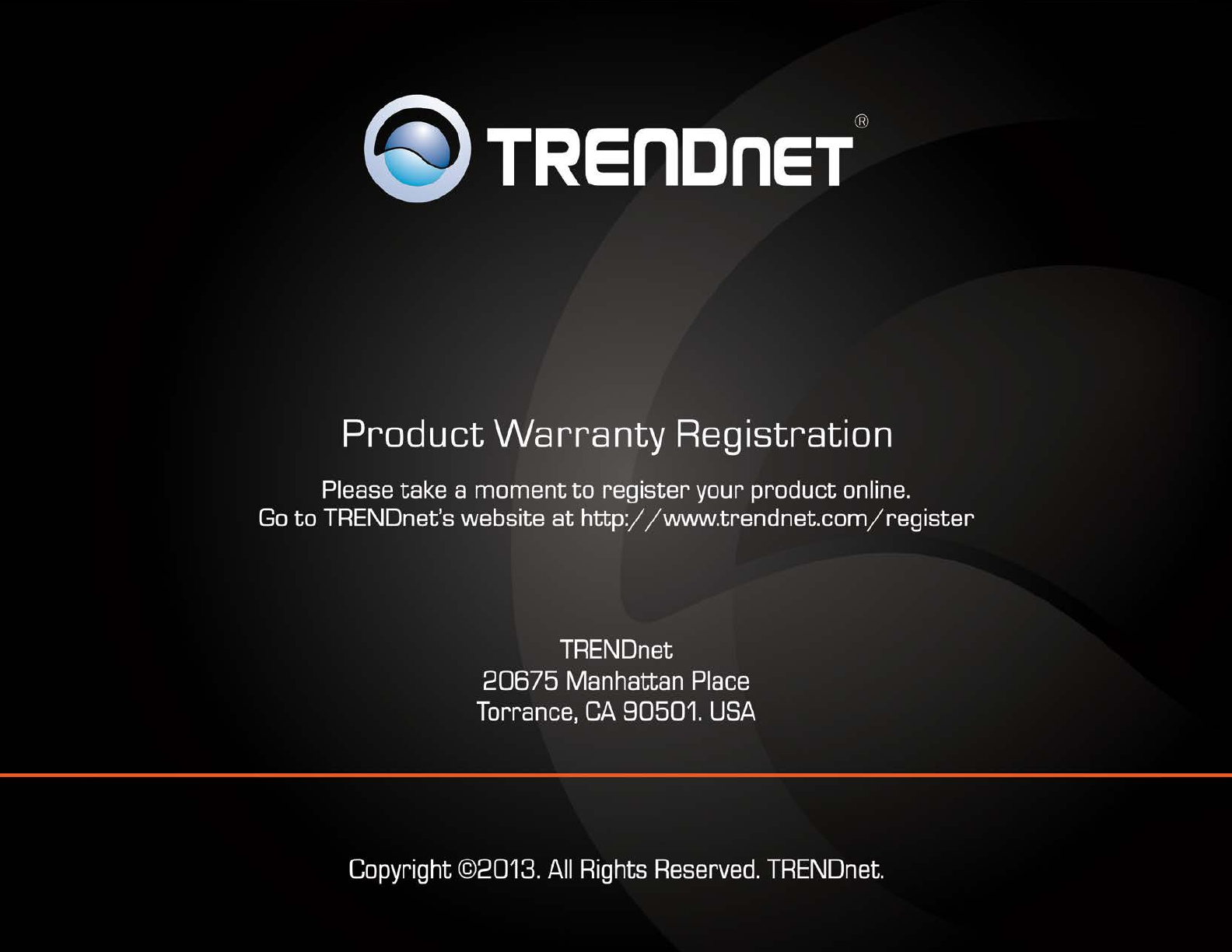Users Manual.pdf
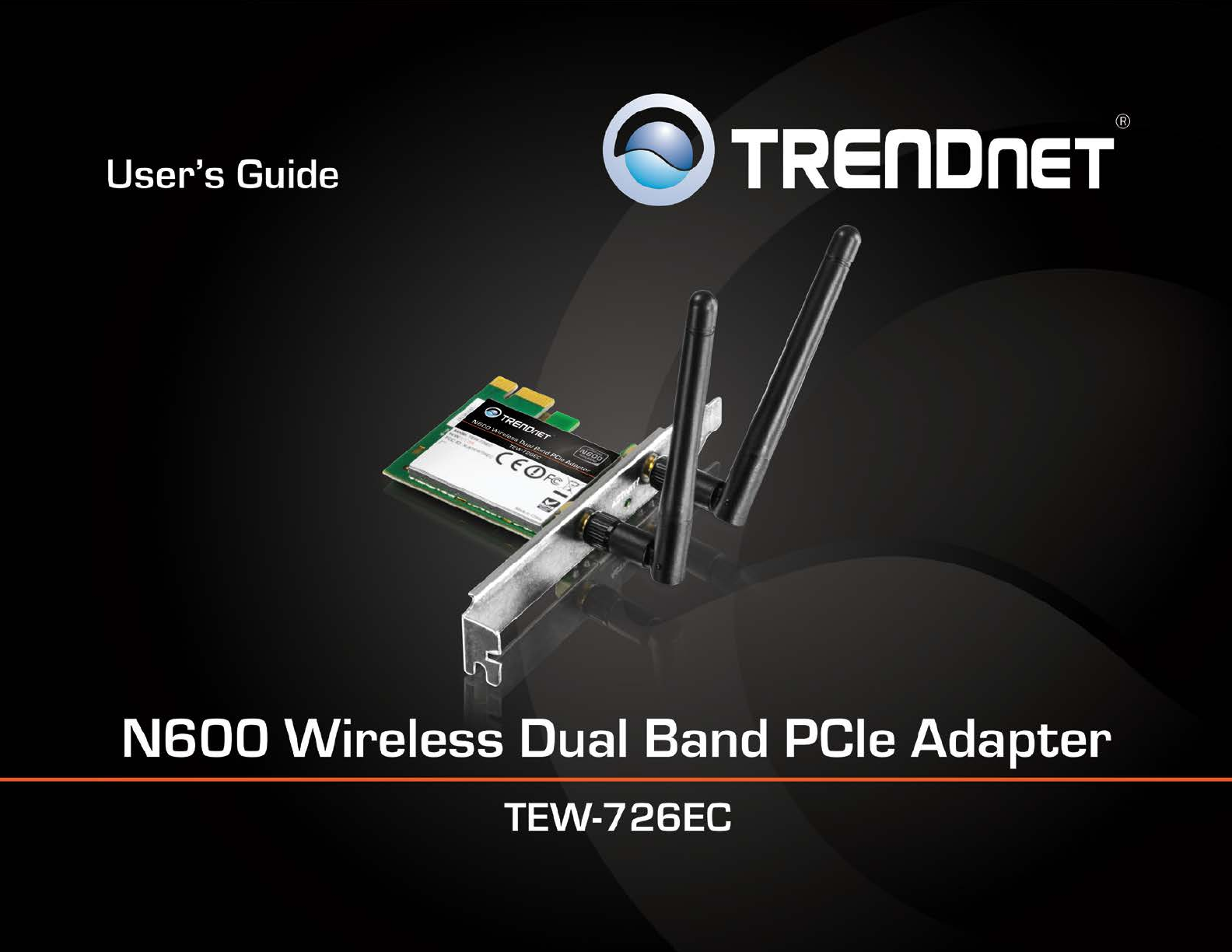
TRENDnet User’s Guide Cover Page

© Copyright 2013 TRENDnet. All Rights Reserved.
TRENDnet User’s Guide Table of Contents
i
Contents
Product Overview ........................................................................... 1
Package Contents .......................................................................................................... 1
Features ......................................................................................................................... 1
Product Hardware Features........................................................................................... 2
System Requirements .................................................................................................... 2
Application Diagram ...................................................................................................... 2
Installing your Wireless Adapter ...................................................... 3
Software Installation...................................................................................................... 3
Hardware Installation .................................................................................................... 5
Using the Wireless Utility ................................................................ 6
Wireless Utility Overview .............................................................................................. 7
Connect to your wireless network ............................................................................... 11
Connect to your wireless network using WPS ............................................................. 12
Create or modify wireless network profiles ................................................................ 15
Technical Specifications................................................................. 17
Troubleshooting ............................................................................ 18
Appendix ...................................................................................... 19
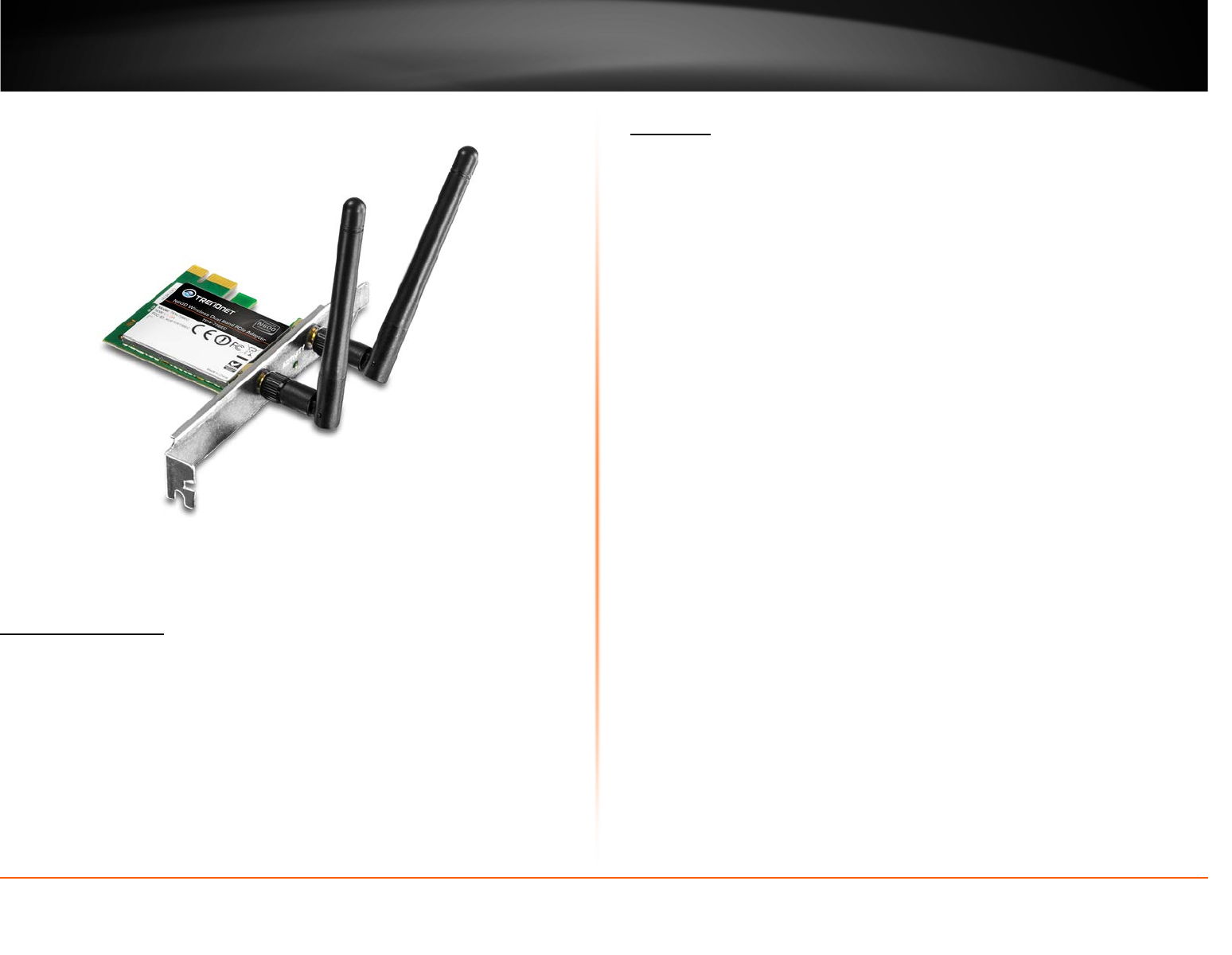
© Copyright 2013 TRENDnet. All Rights Reserved.
TRENDnet User’s Guide TEW-726EC
1
Product Overview
TEW-726EC
Package Contents
In addition to your wireless adapter, the package includes:
• CD-ROM (Utility & Drivers)
• Multi-Language Quick Installation Guide
• Standard and Low Profile Brackets
If any package contents are missing or damaged, please contact the retail store, online
retailer, or reseller/distributor from which the product was purchased.
Features
TRENDnet’s N600 Wireless Dual Band PCIe Adapter, model TEW-726EC, upgrades a
desktop computer to proven 300 Mbps dual band wireless speed and coverage.
Quickly connect to a common 2.4 GHz or a less congested 5 GHz wireless network to
seamlessly stream HD video and surf the internet. Advanced WPA and WPA2 encryption
protects your wireless network.
Multiple Input Multiple Output (MIMO) antenna technology increases wireless coverage
and signal strength. WMM® Quality of Service (QoS) technology prioritizes gaming,
Internet calls, and video streams.
• Wi-Fi compliant with IEEE 802.11n standard (dual band 802.11n 2.4 GHz or 5
GHz connection)
• Backwards compatible with IEEE 802.11g, IEEE 802.11b, and IEEE 802.11a
networks
• Detachable antennas
• Low profile bracket included
• LED activity indicator
• PCI Express interface
• Multiple Input Multiple Output (MIMO) antenna technology
• Wi-Fi Multimedia (WMM) Quality of Service (QoS) data prioritization
• Supports Infrastructure mode via Access Point and ad-hoc network via peer to
peer communication
• Maximum reliability, throughput, and connectivity with Automatic Data Rate
Switching
• Supports advanced wireless encryption up to WPA2-RADIUS
• Compatible with Windows 8 (32/64-bit), 7 (32/64-bit), Vista (32/64-bit), and XP
(32/64-bit) operating systems
• Easy user setup & diagnostic utilities
• Coverage of up to 100 meters indoor (330 feet) and 300 meters outdoor (980
feet) *
*Maximum wireless signal rates are referenced from IEEE 802.11 theoretical specifications. Actual
data throughput and coverage will vary depending on interference, network traffic, building
materials and other conditions.
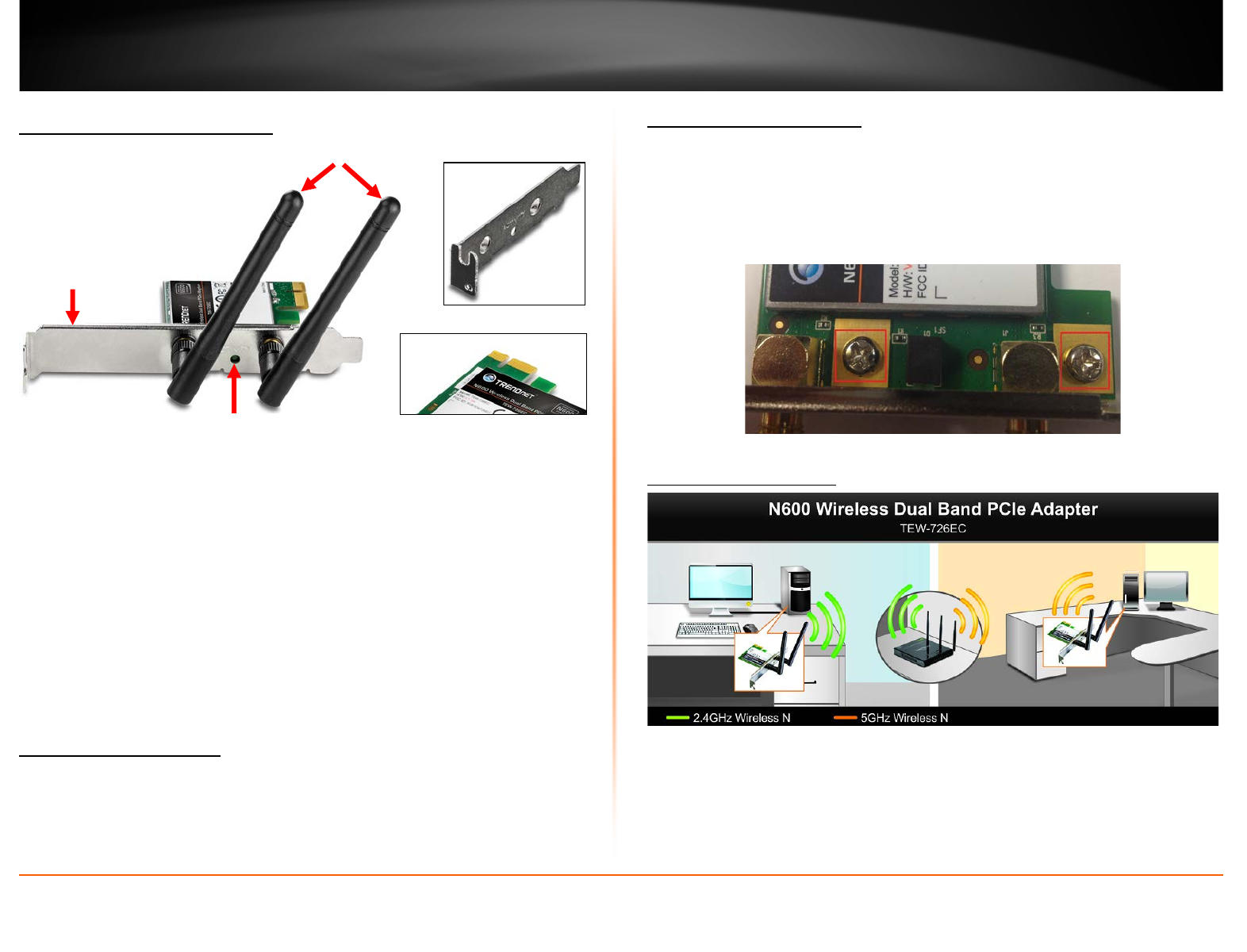
© Copyright 2013 TRENDnet. All Rights Reserved.
TRENDnet User’s Guide TEW-726EC
2
Product Hardware Features
• Detachable antennas – The external 2dBi antennas can be attached/detached to
the reverse SMA connectors located on the PCIe adapter.
• Activity LED Indicator -This LED turns solid when a wireless connection is
established and blinks during wireless data transmission. The LED will blink every 10
sec. when disconnected. If WPS (Wi-Fi Protected Setup) is activated using the
included utility, the LED will blink rapidly.
• Low Profile Bracket – In addition to the standard PCI bracket, a low profile PCI
bracket is included to allow installation of this adapter into computer cases that
only accept the size of low profile PCI cards instead the standard larger PCI size.
System Requirements
• Windows 8 (32/64-bit), Windows 7 (32/64-bit), Vista (32/64-bit), or XP (32/64-
bit)
• Available PCIe (PCI Express x1) slot
• CD-ROM Drive (Driver & Utility Installation with included CD)
Installing the low profile bracket
Using a Philips screwdriver (not included), remove the 2 screws in the PCIe card holding
the bracket in place by turning the screws counter clockwise and remove the standard
size bracket. Once the standard size bracket is removed, attach the low profile bracket.
Using a Philips screwdriver, secure the bracket to the card by driving the 2 screws into
the slots where they were removed before by turning them clockwise until tightened.
Once the bracket is secured, the antennas can be reattached.
Application Diagram
Each desktop computer has the wireless dual band PCIe adapter installed. One desktop
computer wirelessly connected to the dual band router using the common 2.4GHz band
and another computer wirelessly connected to the dual band router using the less-
congested 5GHz band.
Detachable antennas Low Profile Bracket
Activity LED
Standard Bracket
PCI Express x1 Interface
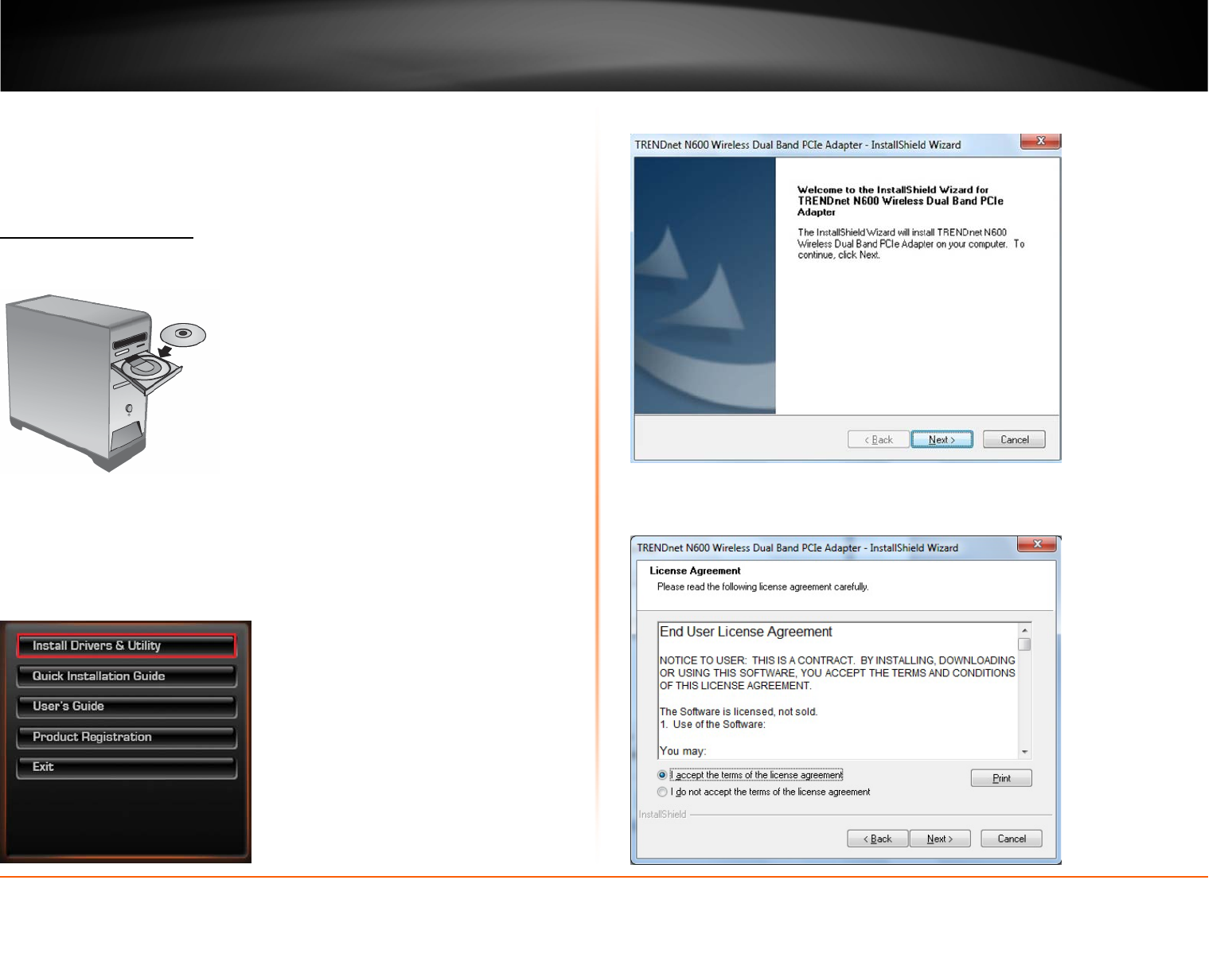
© Copyright 2013 TRENDnet. All Rights Reserved.
TRENDnet User’s Guide TEW-726EC
3
Installing your Wireless Adapter
This section describes how to install the software driver and utility for the wireless
adapter.
Software Installation
1. Insert the included CD-ROM into your computer’s CD-ROM drive.
2. At the CD Autorun Prompt window, click Run Autorun.exe.
Note: If the Autorun prompt does not appear automatically, open the CD contents
and double-click Autorun.exe.
3. At the CD-ROM main menu, click Install Drivers & Utility.
4. At the installation window, click Next.
5. You will be prompted to accept the end user license agreement. Select I accept the
terms of the license agreement and click Next.
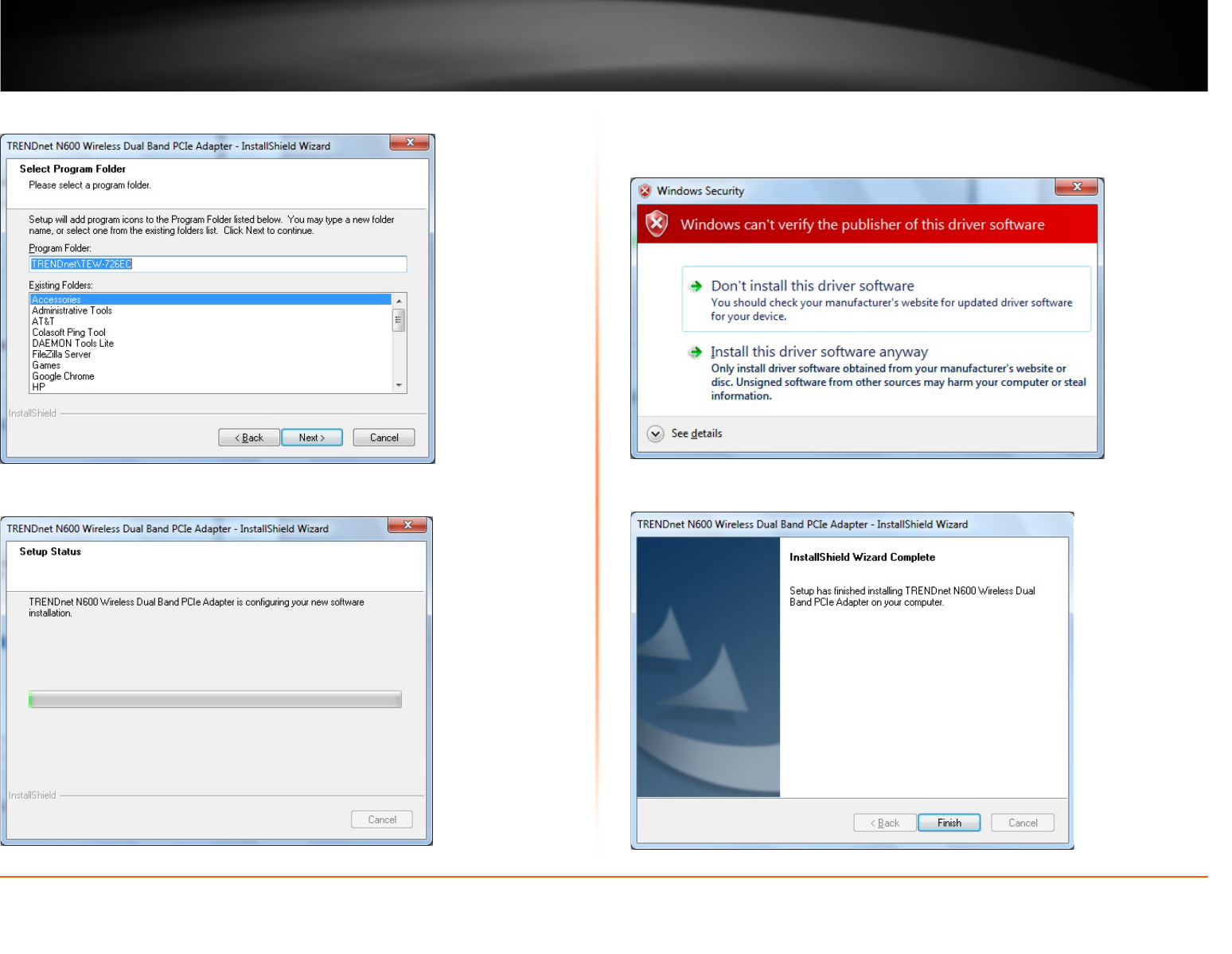
© Copyright 2013 TRENDnet. All Rights Reserved.
TRENDnet User’s Guide TEW-726EC
4
6. At the Install Location window, click Next.
7. Wait for the utility and drivers installation to complete.
8. You may receive a security prompt about the publisher of the driver software. If
prompted, click Install this driver software anyway.
Note: If you do not receive a security prompt, continue to the next step.
9. After the process is completed, click Finish.
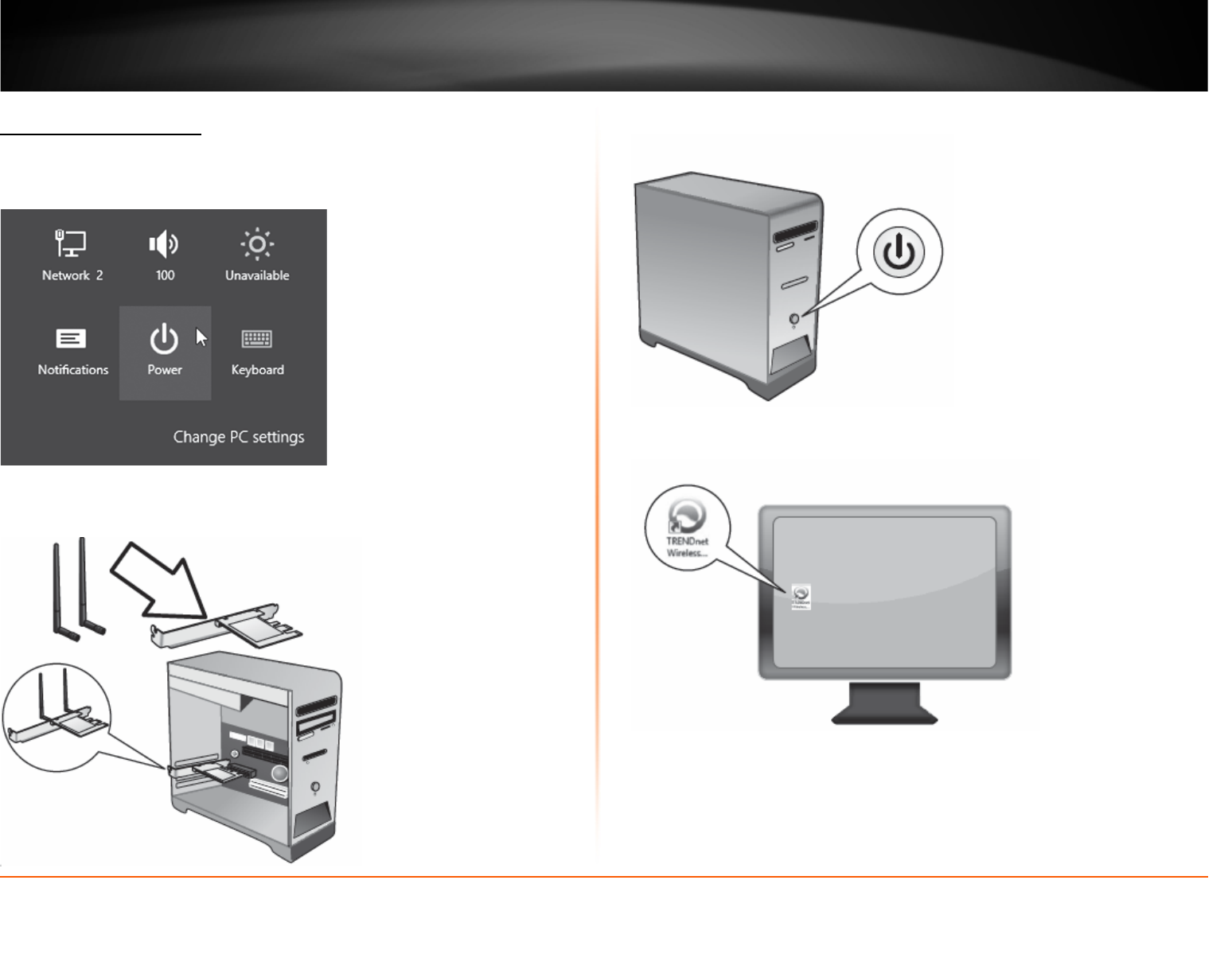
© Copyright 2013 TRENDnet. All Rights Reserved.
TRENDnet User’s Guide TEW-726EC
5
Hardware Installation
1. Shut down your computer.
Note: Shutdown menu option may vary in appearance depending on your operating
system.
2. Open your computer case and insert the wireless dual band PCIe card into an
available PCI Express slot. Once installed, attached the antennas to PCIe card.
3. Close the computer case, and turn on your computer.
4. Locate and double click the TRENDnet Wireless Utility icon.
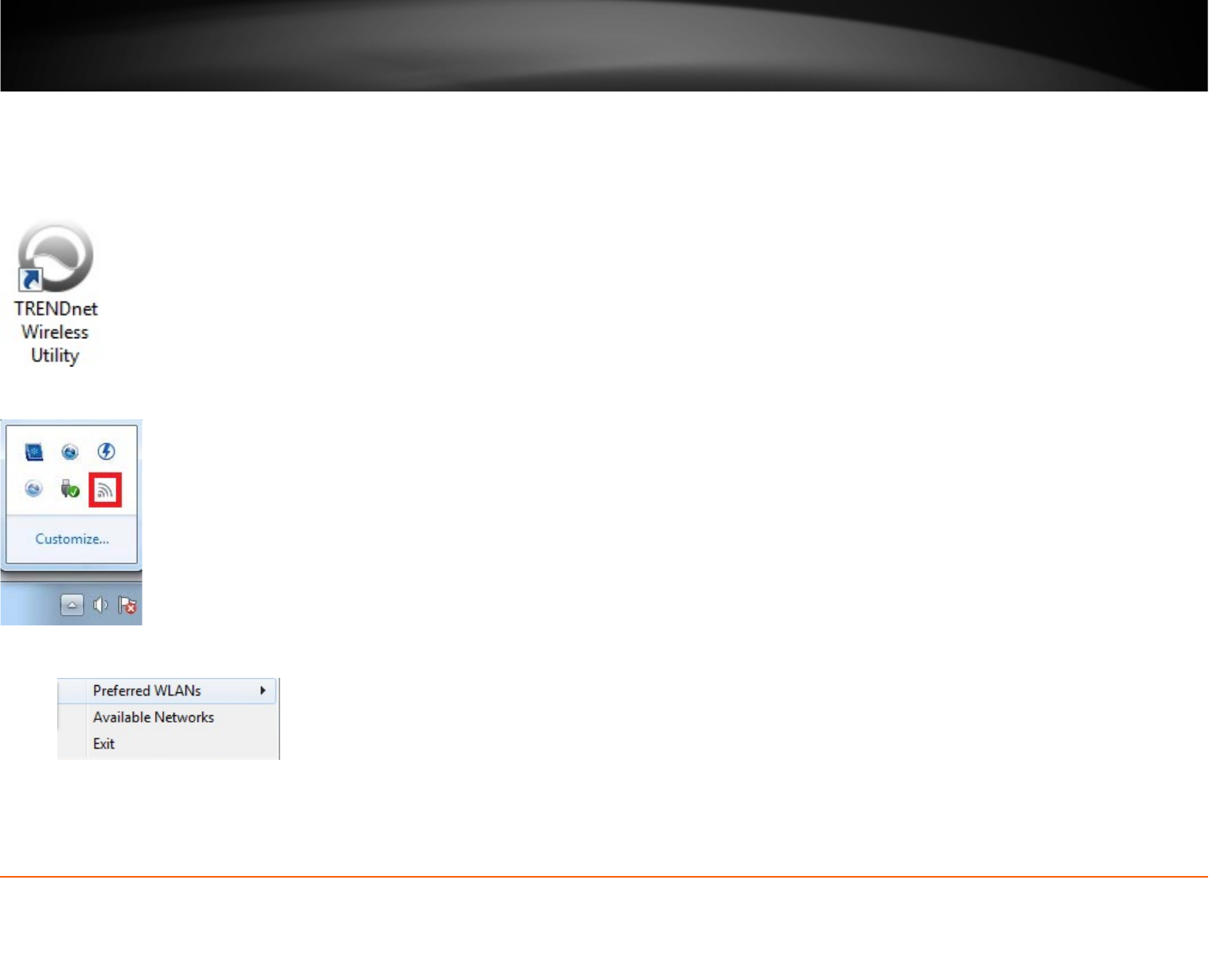
© Copyright 2013 TRENDnet. All Rights Reserved.
6
TRENDnet User’s Guide TEW-726EC
Using the Wireless Utility
Upon completing the software installation, a desktop shortcut is automatically created.
After installation, the software utility will start and open up automatically. If the utility does not start and open up automatically, double-click the desktop icon to start the utility.
When the utility is started, you will the following icon in your system tray in the bottom right corner of the screen.
You can right-click the system tray icon for additional options.
• Preferred WLANs – This option allows to you easily connect to networks you have already connected to prior which are saved in the Profile Management window (Page 8).
• Available Networks – This option will open up the utility and bring you to the Available Networks window (Page 7).
• Exit – This option will close the utility and terminate the application. The application will no longer be running and accessible from your system tray. You will have to restart the
application manually by double-clicking the Desktop icon.
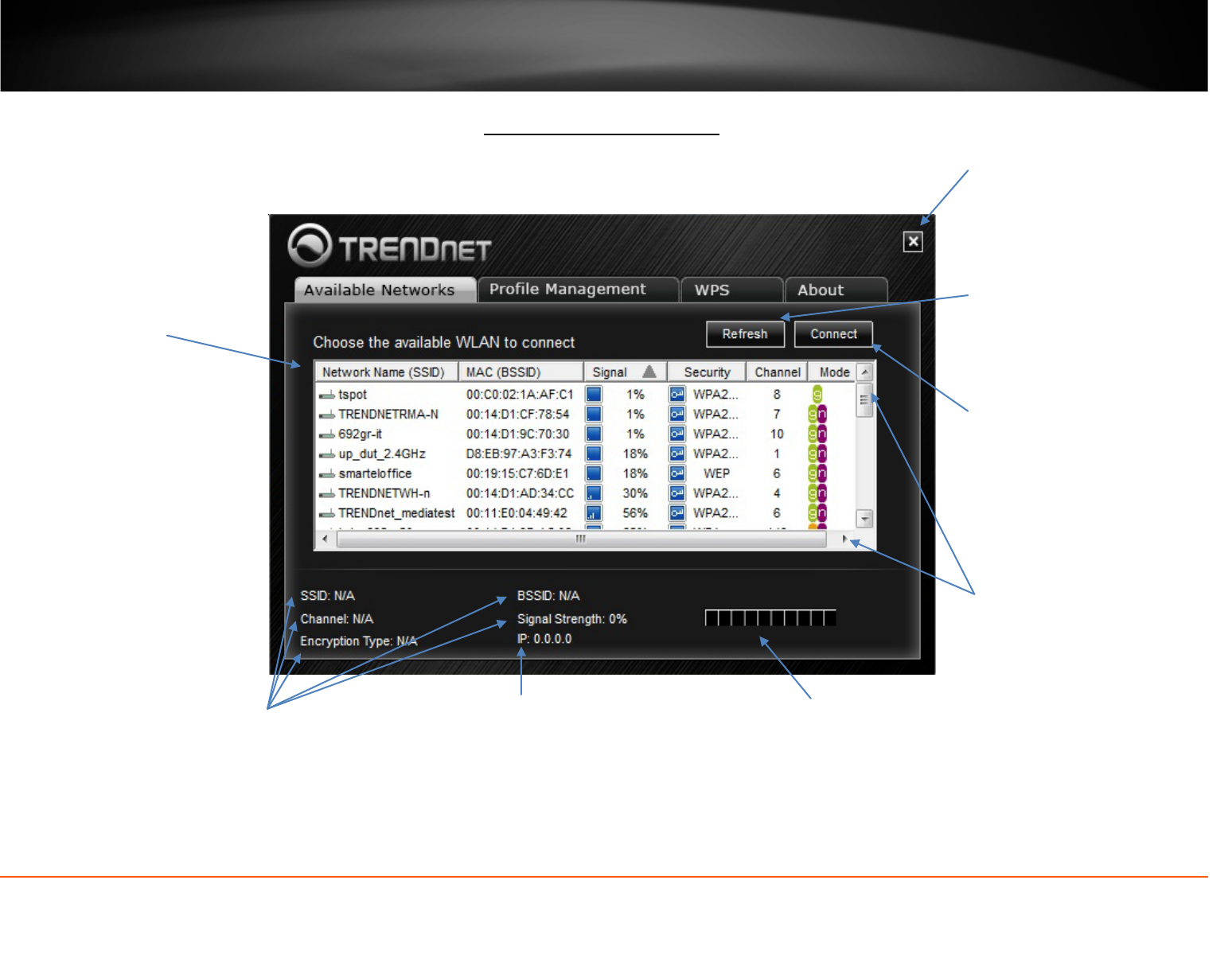
© Copyright 2013 TRENDnet. All Rights Reserved.
TRENDnet User’s Guide TEW-726EC
7
Wireless Utility Overview
Available Networks Window
This window allows you to discover and connect to available wireless networks.
Refresh
If you do not find your wireless
network in the available networks
list, click Refresh to rescan for
available wireless networks.
Connect
After selecting the wireless network
in the available networks list, you
can click Connect to connect to the
network or simply double-click the
network in the list. If the wireless
network has security enabled, you
b t d t t
Close
To close the utility, click Close. This
does not terminate the wireless
utility application and can still be
accessed through the system tray
or desktop icons.
Available Networks List
This window displays a list of the
available wireless networks found
by your wireless adapter. In
addition to displaying the wireless
network name (SSID, the list will
display additional information about
the network such as MAC address
(BSSID), signal strength percentage,
security type, channel, and mode
(a,b,g,n).
Note: Since this adapter has dual-
band capability, available wireless
network found on both the 2.4GHz
band and 5GHz band will be
displayed in the list.
SSID, Channel, Encryption Type, BSSID,
Signal Strength
This will display the wireless network
name (SSID), channel, and
security/encryption type, MAC address
(BSSID), and Signal Strength of the
wireless network you are currently
connected.
IP
This will display the IP address of your
wireless adapter assigned by the
wireless network you are currently
connected. Typically, the IP address is
automatically assigned to your wireless
adapter by the wireless network upon
successful connection.
Signal Strength/Link Quality
The bars provide a graphical
representation of the general signal
strength and link connectivity to the
wireless network you are currently
connected.
Vertical/Horizontal Scroll
You can click the arrows or click and
drag the slider, to display more
available networks or information.
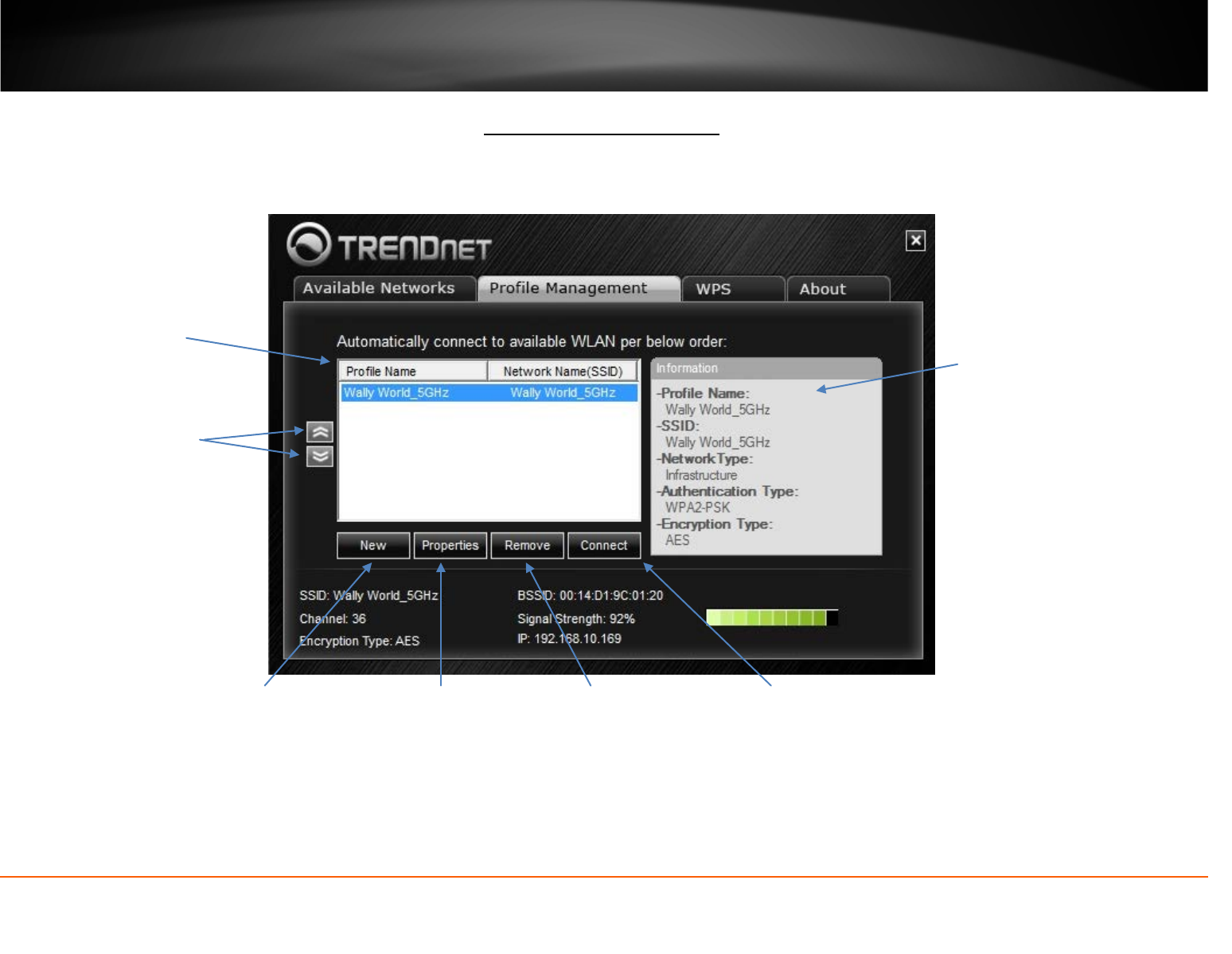
© Copyright 2013 TRENDnet. All Rights Reserved.
TRENDnet User’s Guide TEW-726EC
8
Wireless Utility Overview
Profile Management Window
This window allows you to create and edit preconfigured wireless network profiles. You can create and manage the created profiles for home, work or public areas.
Wireless Network Profile Order
The buttons allow you to set the priority
order in which to connect to your
network profiles, top entry being first.
If you lose connectivity to a currently
connected network, the wireless
adapter will automatically attempt to
connect to network profiles defined in
the list in order starting from the top. If
the network in the first profile is
unavailable after an undefined number
of retries, then the adapter will move on
to the next profile defined.
Wireless Network Profile List
When connecting to available networks,
they are automatically saved to the
profile list.
New
This allows you to
manually add a
new wireless
network profile to
the list.
Properties
This allows you to
modify the settings of
an existing wireless
network profile such as
security settings. You
must first select an
existing profile in the
list to modify.
Remove
This allows you to
remove an existing
wireless network profile
in the list. You must first
select an existing profile
in the list to remove.
Connect
This allows you to
manually connect to an
existing wireless network
profile in the list
regardless of the order
set. You must first select
an existing profile in the
list to connect.
Information
This section displays general
information about the selected wireless
network profile. You must first select an
existing profile in the list to view any
information.
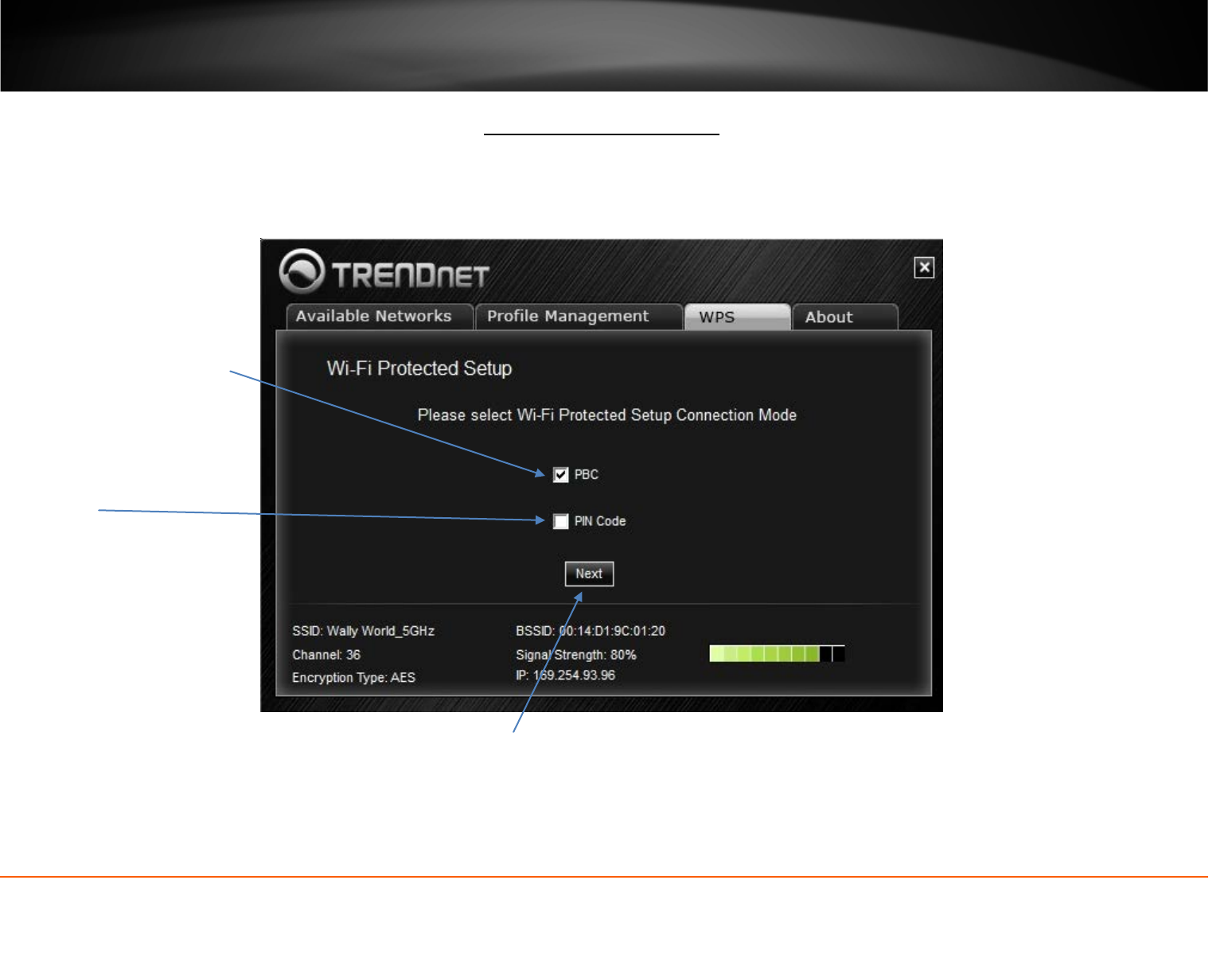
© Copyright 2013 TRENDnet. All Rights Reserved.
TRENDnet User’s Guide TEW-726EC
9
Wireless Utility Overview
WPS (Wi-Fi Protected Setup) Window
This window allows you to establish wireless connectivity using WPS to WPS supported device such as a wireless router/access point.
For information on how to connect using WPS, please refer to the section “Connect to your wireless network using WPS” on page 12.
WPS Push Button Method (Default)
Allows you to establish wireless
connectivity to a WPS supported device
such as a wireless router/access point
using the WPS Push Button method.
WPS PIN Method
Allows you to establish wireless
connectivity to a WPS supported device
such as a wireless router/access point
using the WPS PIN method.
Next
After selecting the WPS method to use,
click Next to continue to remaining
steps of the WPS connection process.
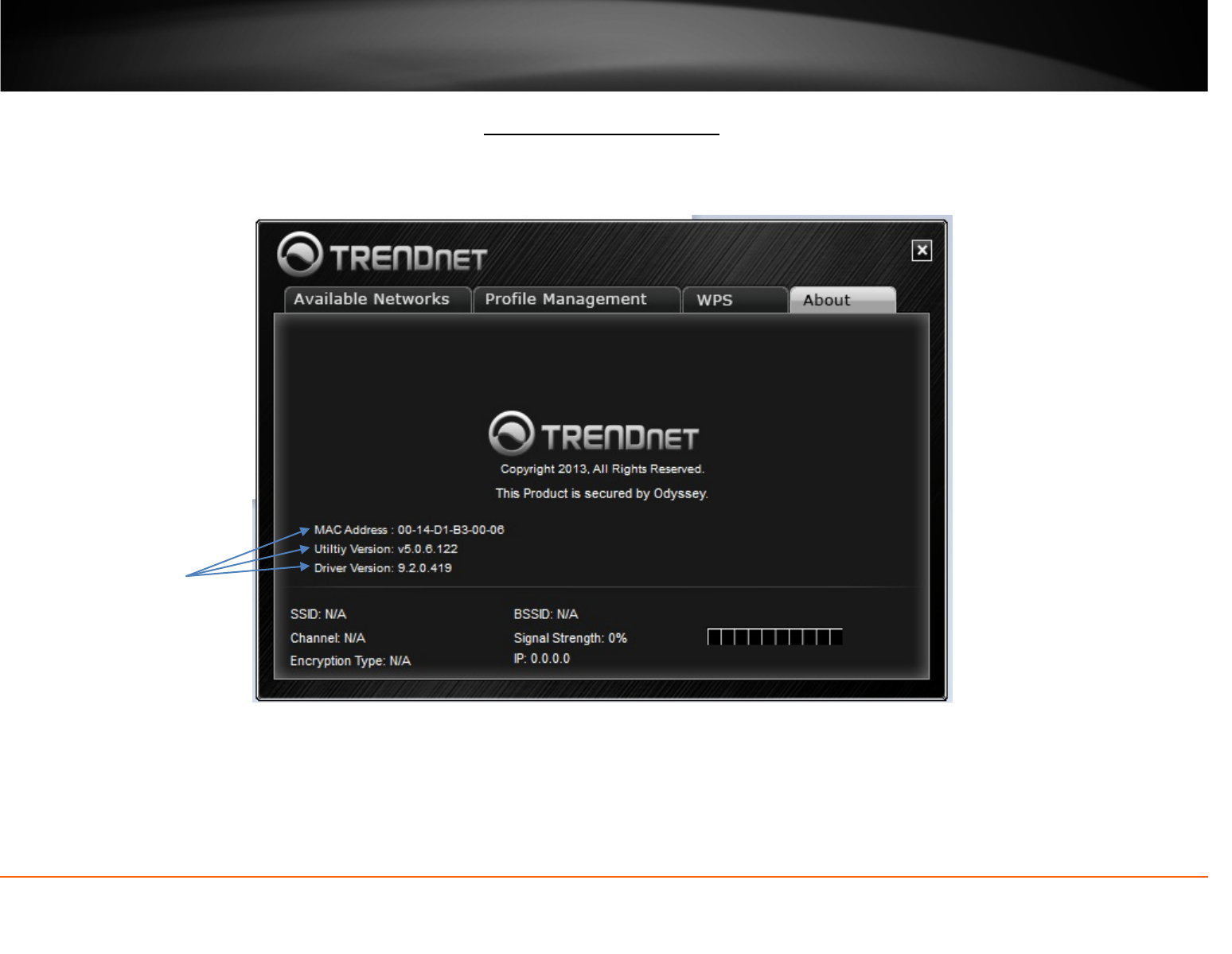
© Copyright 2013 TRENDnet. All Rights Reserved.
TRENDnet User’s Guide TEW-726EC
10
Wireless Utility Overview
About Window
This window displays the wireless adapter MAC address, driver, and utility version reference information.
MAC Address, Utility & Driver Version
Displays the wireless adapter MAC
address, utility, and driver version
reference information.
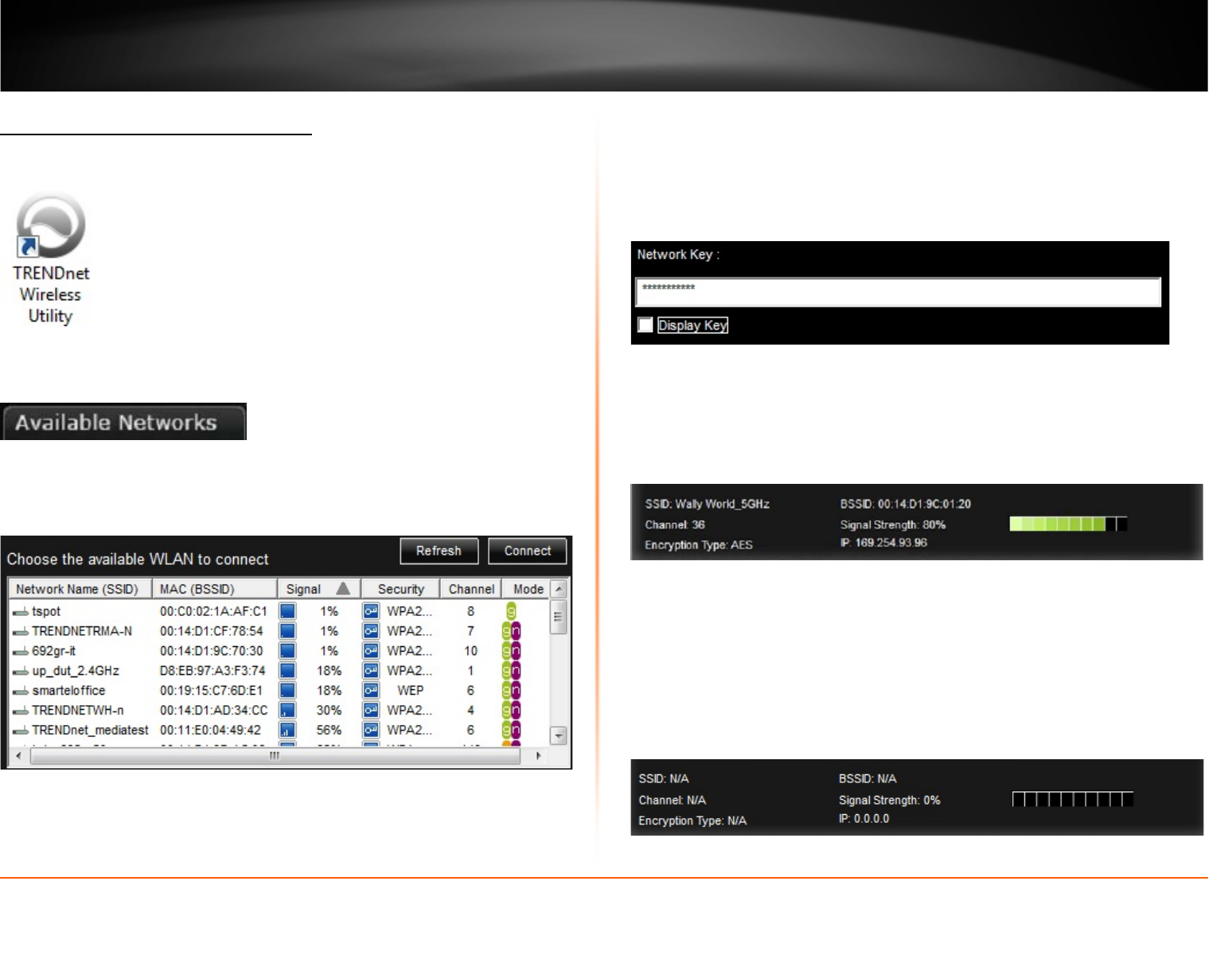
© Copyright 2013 TRENDnet. All Rights Reserved.
TRENDnet User’s Guide TEW-726EC
11
Connect to your wireless network
1. Open up the wireless utility.
2. Click on the Available Networks tab.
3. In the list, double click on your wireless network or select y our wireless network and
click the Connect button.
3. If your network has security enabled, you will be prompted to enter the Network Key
and the encryption type will be detected automatically. Enter the Network Key and click
Connect.
Note: After entering the network key, you can click Display Key to show the characters
you typed in for the network key to verify it is correct.
4. The wireless network information will appear at the bottom of the utility of the
wireless network you are connected and the Signal Strength/Link Quality bars will turn
green to indicate a successful connection.
Connection Successful
Note: If there is no information displayed and the bars do not turn green, you were not
connected to the wireless network successfully. Please delete the wireless network from
the Profile tab and repeat this process to verify if your key may have been entered
incorrectly. If you are still experiencing issues connecting to your wireless network, you
may need to verify the security settings of your wireless network to make sure they
correct key is entered.
Connection Unsuccessful
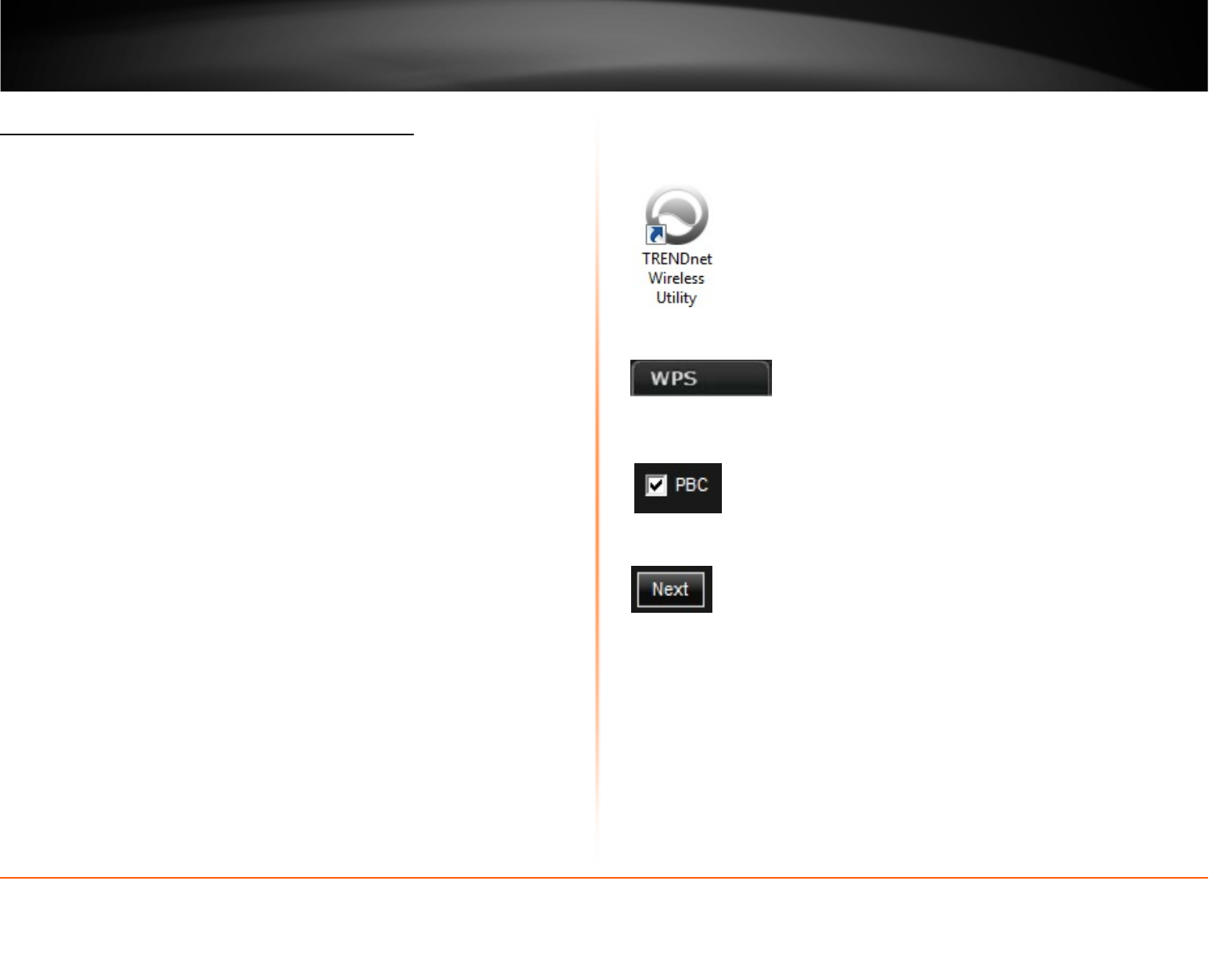
© Copyright 2013 TRENDnet. All Rights Reserved.
TRENDnet User’s Guide TEW-726EC
12
Connect to your wireless network using WPS
WPS (Wi-Fi Protected Setup) is a feature that makes it easy to connect devices to your
wireless network. If your wireless router/access point supports WPS, you can use this
feature to easily connect wireless devices to your network.
Note: You can typically find out if you if your wireless router/access point supports WPS
just by looking at the physical device. There should be a WPS push button located on the
exterior casing of the device, if not, your device may not support WPS or you may need
to reference your device documentation as to how WPS can be initiated on the deivce. If
your device does not have an identifiable WPS push button on the exterior location, we
would recommend using the standard connection method on the previous page.
There are two methods the WPS feature can easily connect your wireless devices to
your network.
• (Recommended) Push Button Configuration (PBC) method
• PIN (Personal Identification Number) Method
(Recommended) Hardware Push Button (PBC) Method
1. Open up the wireless utility.
2. Click on the WPS tab.
3. In the WPS window, the Push Button Configuration (PBC) option will be selected by
default. If not, check the PBC option.
4. Click Next.
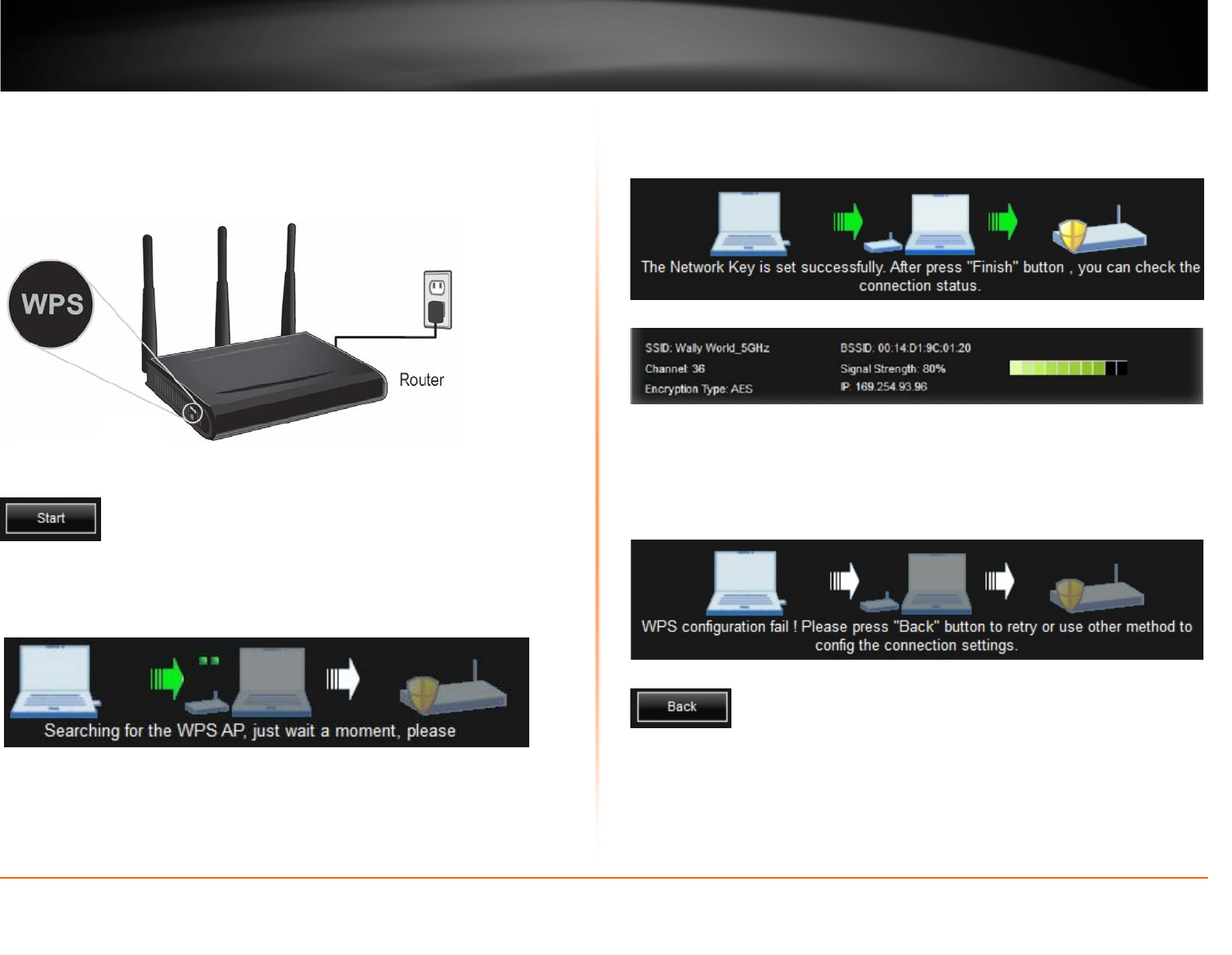
© Copyright 2013 TRENDnet. All Rights Reserved.
TRENDnet User’s Guide TEW-726EC
13
5. On your wireless router/access point, push the WPS button.
Note: Typically, the WPS button hold time is 3-5 sec., then release. For TRENDnet
routers/access points, the WPS hardware push button hold time is 3 seconds. If you are
using another brand device, you may need to refer to your device documentation.
6. On the wireless utility, click Start.
7. A message will appear at the top of the utility indicating that the WPS process has
been activated. Wait for the process to complete.
.
8. If successful, you will see the following message at the top and the connection
information at the bottom of the utility will appear.
Note: If the WPS process fails, you will see the message below and connection
information at the bottom of the utility will not be displayed. You may need to click Back
and attempt the WPS process again. You may need to refer to your wireless
router/access point documentation regarding the operation of WPS.
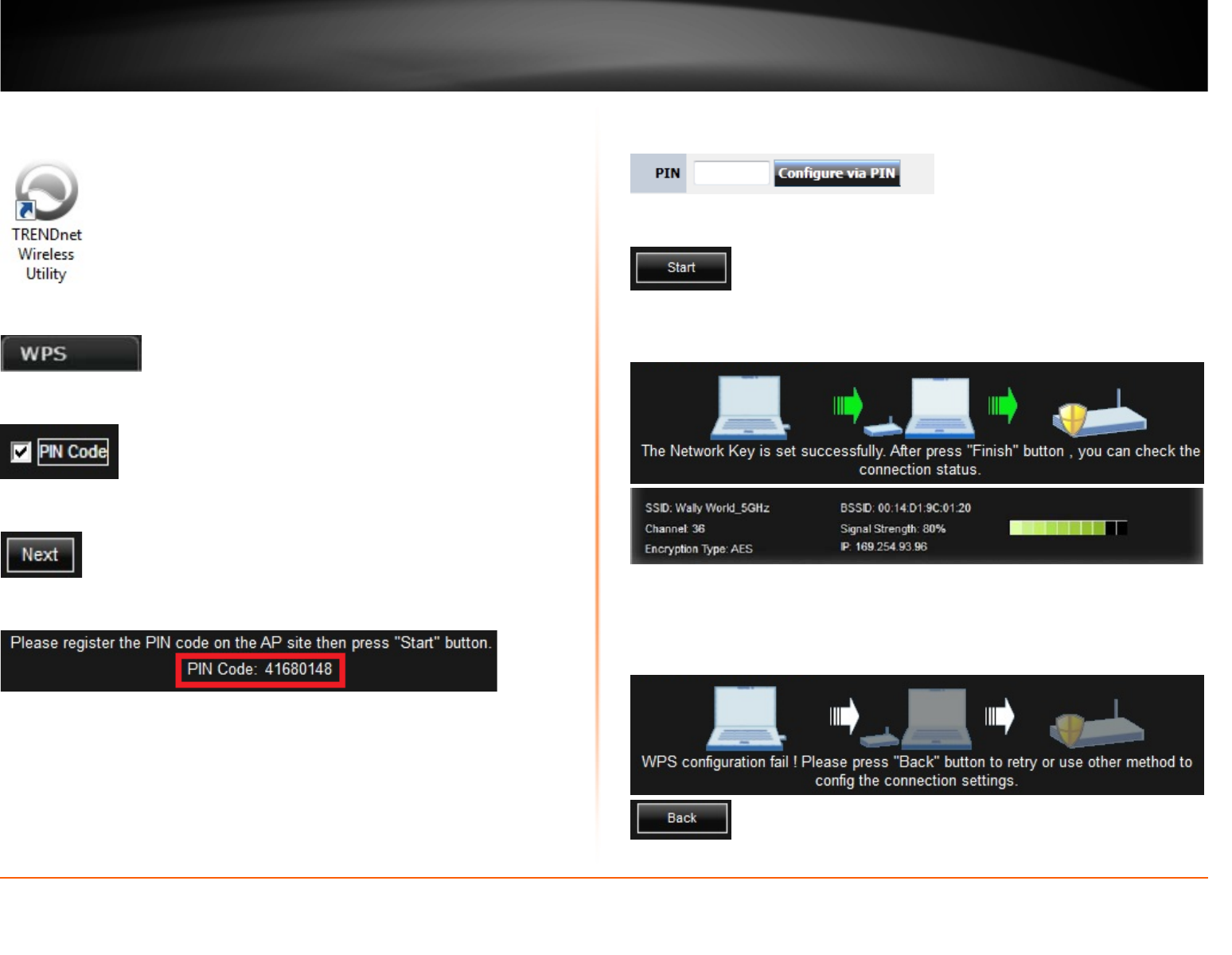
© Copyright 2013 TRENDnet. All Rights Reserved.
TRENDnet User’s Guide TEW-726EC
14
PIN (Personal Identification Number) Method
1. Open up the wireless utility.
2. Click on the WPS tab.
3. Check the PIN Code option.
4. Click Next.
5. The client PIN Code will be generated automatically.
6. On your wireless router/access point, enter the client PIN Code into your wireless
router/access point configuration page and start the WPS process.
Note: You will need to access the device configuration page (typically through a web
browser) to access the WPS section to enter the client PIN code and use the WPS PIN
method. You may need to refer to your device documentation on how to access your
device’s configuration page and locate the WPS section. The example below (from our
TRENDnet TEW-692GR router) shows where the WPS client PIN information is entered.
6. On the wireless utility, click Start.
8. If successful, you will see the following message at the top and the connection
information at the bottom of the utility will appear.
Note: If the WPS process fails, you will see the message below and connection
information at the bottom of the utility will not be displayed. You may need to click Back
and attempt the WPS process again. You may need to refer to your wireless
router/access point documentation regarding the operation of WPS.
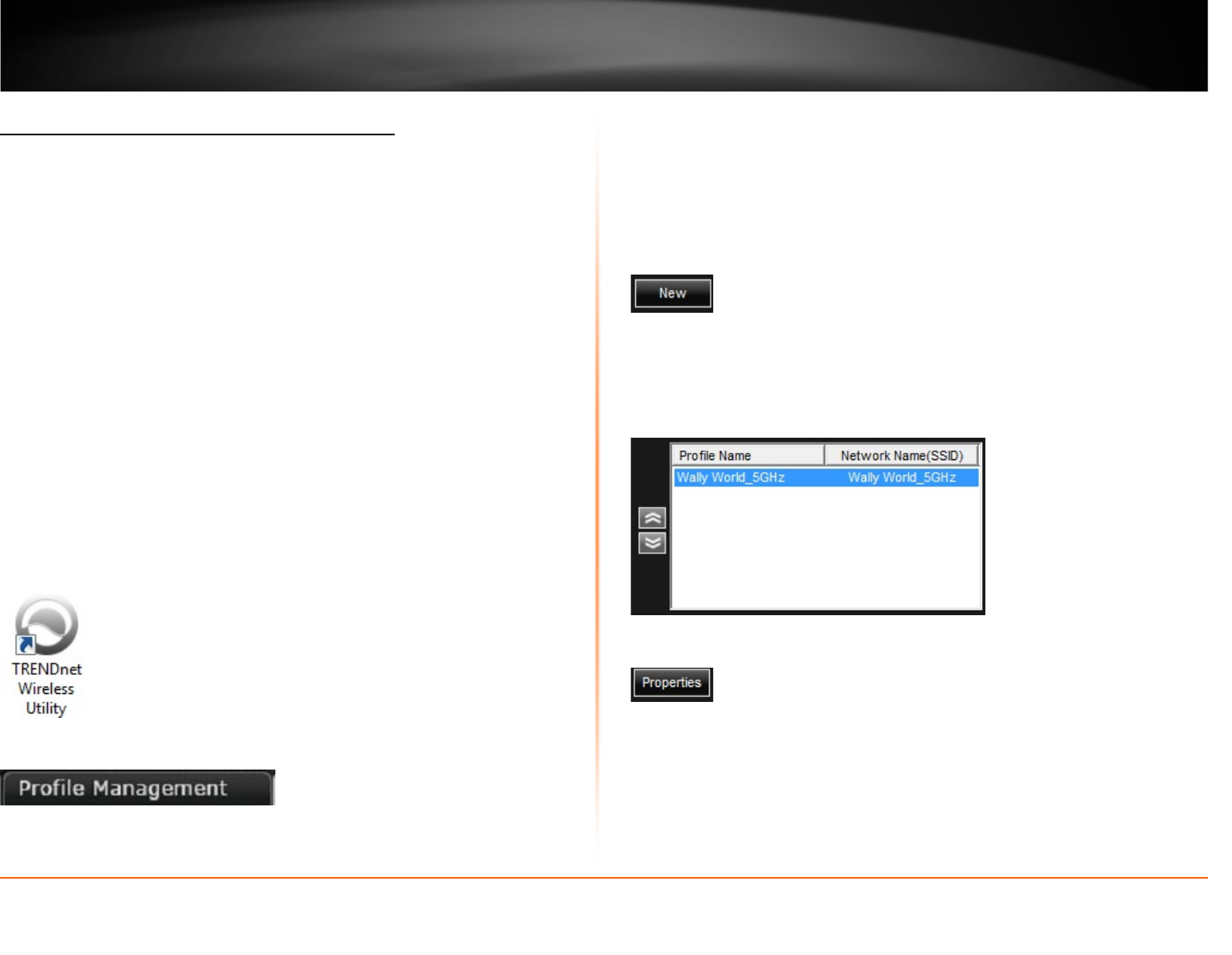
© Copyright 2013 TRENDnet. All Rights Reserved.
TRENDnet User’s Guide TEW-726EC
15
Create or modify wireless network profiles
Wireless network profiles are profiles that define the parameters of an existing network
such as the wireless network name (SSID) and security settings in order to allow for
easier management especially if you connect to multiple wireless networks. When you
connect to a wireless network using the Available Networks window, a profile for that
network is automatically saved to your profile list so that the next time you are in range
of that network, your computer will automatically connect to that predefined wireless
network without having to manually scan and reconnect to the network.
When a parameter (wireless network name or security key) changes in a wireless
network that you had connected to before and saved to the profile list, you may need to
modify the profile of that network and change to the correct parameters in order to
reconnect.
If you are connecting to a wireless network where the wireless network name (SSID) is
not discoverable for security purposes, you may need to manually add a new profile to
the list for this network in order to connect.
Please note that these parameters are set based on the configuration parameters
required by the wireless router/access point.
For additional information on security parameters, you can refer to the Appendix.
1. Open up the wireless utility.
2. Click on the Profile Management tab.
You can either create a new wireless network profile or modify an existing profile in the
list.
a. New Profile
Click New to create a new profile.
OR
b. Modify an existing Profile
To modify an existing profile, click the profile in the list.
Click Properties.
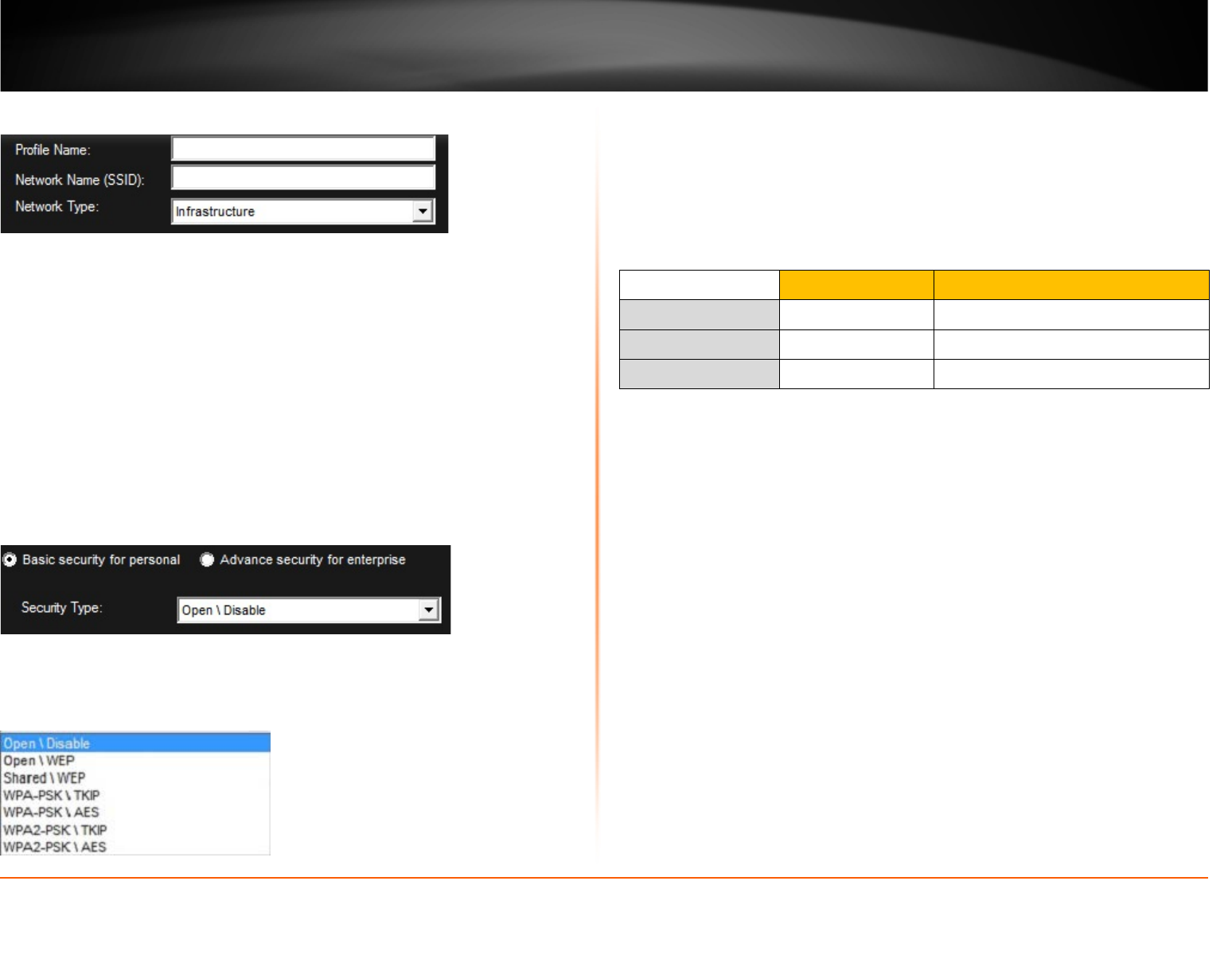
© Copyright 2013 TRENDnet. All Rights Reserved.
TRENDnet User’s Guide TEW-726EC
16
Enter or modify the parameters for the wireless network profile.
• Profile Name – Enter a name you easily identify in your profile list, for example
“Home” or “Office”. Please note that this is not the same as your wireless
network name and does not need to be the same as your wireless network
name.
• Network Name (SSID) – Enter the wireless network name of the network you
are connecting.
• Network Type – The most typical configuration type is Infrastructure which is
used when connecting to a wireless router/access point. Ad-Hoc is only used
when establishing a wireless one-to-one only connection with another wireless
device or computer operating in ad-hoc mode.
There are 2 security categories to choose.
Basic security for personal – Includes the most common security options under the
Security Type drop-down menu.
• Open \ Disable – Wireless network has no security configured. No key is
required.
• Open or Shared \ WEP – Enter the WEP key for your wireless network. Wireless
network has WEP security enabled, open or shared. Please note that the Key
Index 1-4 must also match the same index configured on the wireless
router/access point.
WEP Key Format
• WPA-PSK \ TKIP or AES – Wireless network has WPA-PSK security enabled,
TKIP or AES.
Note: 8-63 alphanumeric characters (a,b,C,?,*, /,1,2, etc.)
• WPA2-PSK \ TKIP or AES – Wireless network has WPA2-PSK security enabled.
TKIP or AES.
Note: 8-63 alphanumeric characters (a,b,C,?,*, /,1,2, etc.)
Advance security for enterprise – Includes all security options including advanced
options under the Security Type drop-down that require additional authentication
parameters to connect to the wireless network typically used offices and businesses that
require a higher level of security.
Additional security options:
• WEP 802.1x – Requires additional certificate installed for authentication.
• WPA-EAP or WPA2-EAP \ TKIP or AES – Wireless network has WPA-EAP
security enabled, TKIP or AES. Select the EAP (Extensible Authentication
Protocol) Type.
o EAP-TLS – Requires additional certificate to be installed on computer
for authentication purposes.
o EAP-PEAP – Requires additional certificate to be installed along with a
password.
WEP Key Format HEX ASCII
Character set 0-9 & A-F, a-f only Alphanumeric (a,b,C,?,*, /,1,2, etc.)
64-bit key length 10 characters 5 characters
128-bit key length 26 characters 13 characters
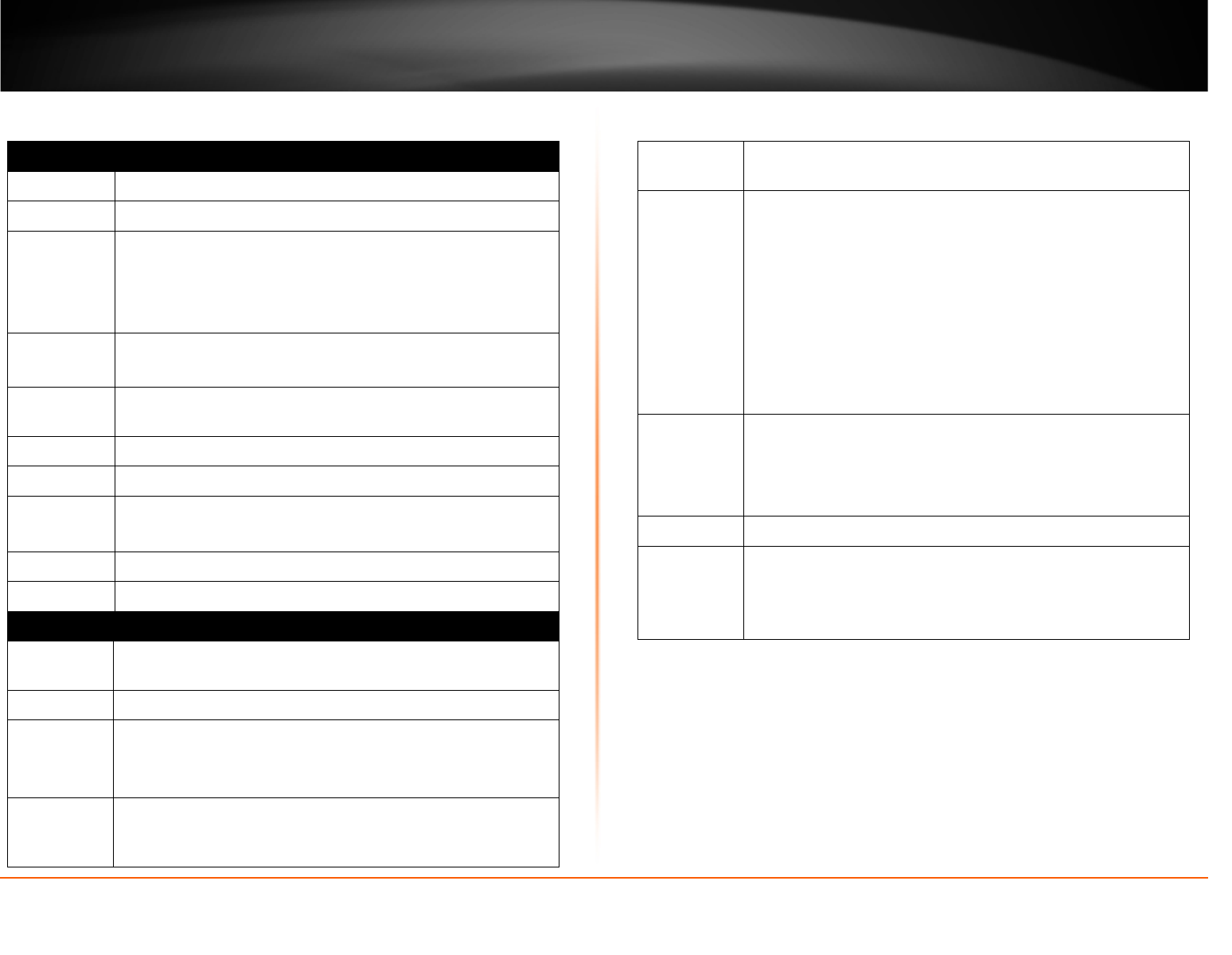
© Copyright 2013 TRENDnet. All Rights Reserved.
TRENDnet User’s Guide TEW-726EC
17
Technical Specifications
Hardware
Interface PCI Express 1.0
Standards IEEE 802.11a, IEEE 802.11b, IEEE 802.11g, IEEE 802.11n
LED Indicator Data transmission: blinking
Link established: solid
WPS (Wi-Fi Protected Setup): blinking rapidly
Disconnected: blinks every ten seconds
Power
Consumption
Transmit mode: 670mA max.
Receive mode: 350mA max.
Supported
OS
Windows 8 (32/64-bit), 7 (32/64-bit), Vista (32/64-bit), XP (32/64-
bit)
Dimensions 66 x 55 mm
Weight 45 g (1.6 oz)
Temperature Operating: 0° ~ 40° C (32° ~ 104° F)
Storage: -20° ~ 75° C (-4° ~ 167° F)
Humidity 90% max. (non-condensing)
Certifications CE, FCC
Wireless
Modulation DBPSK, DQPSK, DSSS, CCK, BPSK, QPSK, 16-QAM/64-QAM with
OFDM
Antenna 2 x 2 dBi dipole detachable antennas with reverse SMA connector
Frequency 802.11b/g/n: 2.400 ~ 2.483 GHz
802.11a/n: 5.150 ~ 5.350 GHz / 5.725 ~ 5.825 GHz (FCC),
5.150 ~ 5.350 GHz / 5.470 ~ 5.725 GHz (ETSI)
Data Rate
(auto
fallback)
802.11a: up to 54 Mbps
802.11b: up to 11 Mbps
802.11g: up to 54 Mbps
802.11n: up to 300 Mbps (for 2.4 or 5 GHz)
Output
Power
2.4 GHz: Typical RF Output Power (tolerance +/- 2dB)
802.11b: 18 dBm
802.11g: 18 dBm
802.11n: HT20: 18 dBm
HT40: 13 dBm
5 GHz: Typical RF Output Power (tolerance +/- 2 dB)
802.11a: 16 dBm
802.11n: HT20: 13 dBm
HT40: 13 dBm
Receiving
Sensitivity
802.11a: -65dBm (typical) at 54 Mbps
802.11b: -76dBm (typical) at 11 Mbps
802.11g: -65dBm (typical) at 54 Mbps
802.11n: -62dBm (typical) at 300 Mbps (for 2.4 or 5 GHz)
Encryption 64/128-bit WEP, WPA / WPA2-PSK, WPA/WPA2-RADIUS
Channels 2.4 GHz: 1~11 (FCC), 1~13 (ETSI)
5 GHz: 36, 40, 44, 48, 149, 153, 157, 161, 165 (FCC) 36, 40, 44, 48,
52, 56, 60, 64, 100, 104, 108, 112, 116, 120, 124, 128, 132, 136,
140 (ETSI)
*Maximum wireless signal rates are referenced from IEEE 802.11 theoretical specifications. Actual
data throughput and coverage will vary depending on interference, network traffic, building
materials and other conditions.

© Copyright 2013 TRENDnet. All Rights Reserved.
TRENDnet User’s Guide TEW-726EC
18
Troubleshooting
Q: I inserted the Utility & Driver CD-ROM into my computer's CD-ROM Drive and the
installation menu does not appear automatically. What should I do?
Answer:
1. For Windows 7, if the installation menu does not appear automatically, click on
the Windows Icon on the bottom left hand corner of the screen,, click the “Search
programs and files” box, and type D:\Autorun.exe, where “D” in
“D:\Autorun.exe” is the letter assigned to your CD-ROM Drive, and then press the
ENTER key on your keyboard
2. For Windows Vista, if the installation menu does not appear automatically, click
Start, click the Start Search box, and type D:\Autorun.exe where "D" in
"D:\autorun.exe" is the letter assigned to your CD-ROM Drive, and then press the
ENTER key on your keyboard.
3. For Windows 2000/XP, if the installation menu does not appear automatically,
click Start, click Run, and type
D:\Autorun where "D" in "D:\Autorun.exe" is the letter assigned to your CD-ROM
Drive, and then press the ENTER key on your keyboard.
Q: I completed all the steps in the quick installation guide, but my Wireless USB
Adapter is not connecting to my access point. What should I do?
Answer:
1. Verify that the SSID (Network Name) matches your wireless router or access
point's SSID
2. Please check with your network administrator for security key in order to access a
secured wireless access point or router. Please refer to the User's Guide for more
information regarding wireless network security.
3. Check your TCP/IP properties to ensure that Obtain an IP address automatically is
selected.
4. Double-click the Wireless Configuration Utility icon, click Available Networks and
then click Refresh to check and see if there are any available wireless networks
listed.
Q: Windows is unable to recognize my hardware. What should I do?
Answer:
1. Make sure your computer meets the minimum requirements as specified in
Section 1 of this quick installation guide.
2. You must complete the installation of the Wireless Configuration Utility (as
described in Section 2) before connecting the Wireless USB Adapter to your
computer.
3. Connect the Wireless USB Adapter to a different USB port on your computer.
Q: I cannot open the Wireless Configuration Utility. What should I do?
Answer:
Access your device manager to make sure the adapter is installed properly.
1. To access the device manager on Windows 7, click on the Windows icon on the
bottom left-hand corner, click Computer, click System Properties and then click
Device Manager.
2. To access the device manager on Windows Vista, right-click Computer, click
Properties and then click Device Manager.
3. To access the device manager on Windows XP, right-click My Computer, click
Properties, click the Hardware tab, and then click Device Manager.
If you see a networking device with a yellow question mark or exclamation point:
1. Uninstall the device from device manager
2. Remove the adapter from the computer
3. Click the Windows / Start icon, click All Programs, click TRENDnet Wireless and
then click Uninstall.

© Copyright 2013 TRENDnet. All Rights Reserved.
TRENDnet User’s Guide TEW-726EC
19
Appendix
How to choose the type of security for your wireless network
Setting up wireless security is very important. Leaving your wireless network open and
unsecure could expose your entire network and personal files to outsiders. TRENDnet
recommends reading through this entire section and setting up wireless security on your
new router.
There are a few different wireless security types supported in wireless networking each
having its own characteristics which may be more suitable for your wireless network
taking into consideration compatibility, performance, as well as the security strength
along with using older wireless networking hardware (also called legacy hardware).
It is strongly recommended to enable wireless security to prevent unwanted users from
accessing your network and network resources (personal documents, media, etc.).
In general, it is recommended that you choose the security type with the highest
strength and performance supported by the wireless computers and devices in your
network. Please review the security types to determine which one you should use for
your network.
Wireless Encryption Types
• WEP: Legacy encryption method supported by older 802.11b/g hardware. This
is the oldest and least secure type of wireless encryption. It is generally not
recommended to use this encryption standard, however if you have old 802.11
b or 802.11g wireless adapters or computers with old embedded wireless
cards(wireless clients), you may have to set your router to WEP to allow the old
adapters to connect to the router. Note: This encryption standard will limit
connection speeds to 54Mbps.
• WPA: This encryption is significantly more robust than the WEP technology.
Much of the older 802.11g hardware was been upgraded (with firmware/driver
upgrades) to support this encryption standard. Total wireless speeds under
this encryption type however are limited to 54Mbps.
• WPA-Auto: This setting provides the router with the ability to detect wireless
devices using either WPA or WPA2 encryption. Your wireless network will
automatically change the encryption setting based on the first wireless device
connected. For example, if the first wireless client that connects to your
wireless network uses WPA encryption your wireless network will use WPA
encryption. Only when all wireless clients disconnect to the network and a
wireless client with WPA2 encryption connects your wireless network will then
change to WPA2 encryption. NOTE: WPA2 encryption supports 802.11n speeds
and WPA encryption will limit your connection speeds to 54Mbps
• WPA2: This is the most secure wireless encryption available today, similar to
WPA encryption but more robust. This encryption standard also supports the
highest connection speeds. TRENDnet recommends setting your router to this
encryption standard. If you find that one of your wireless network devices does
not support WPA2 encryption, then set your router to either WPA or WPA-Auto
encryption.
Note: Check the specifications of your wireless network adapters and wireless appliances
to verify the highest level of encryption supported.
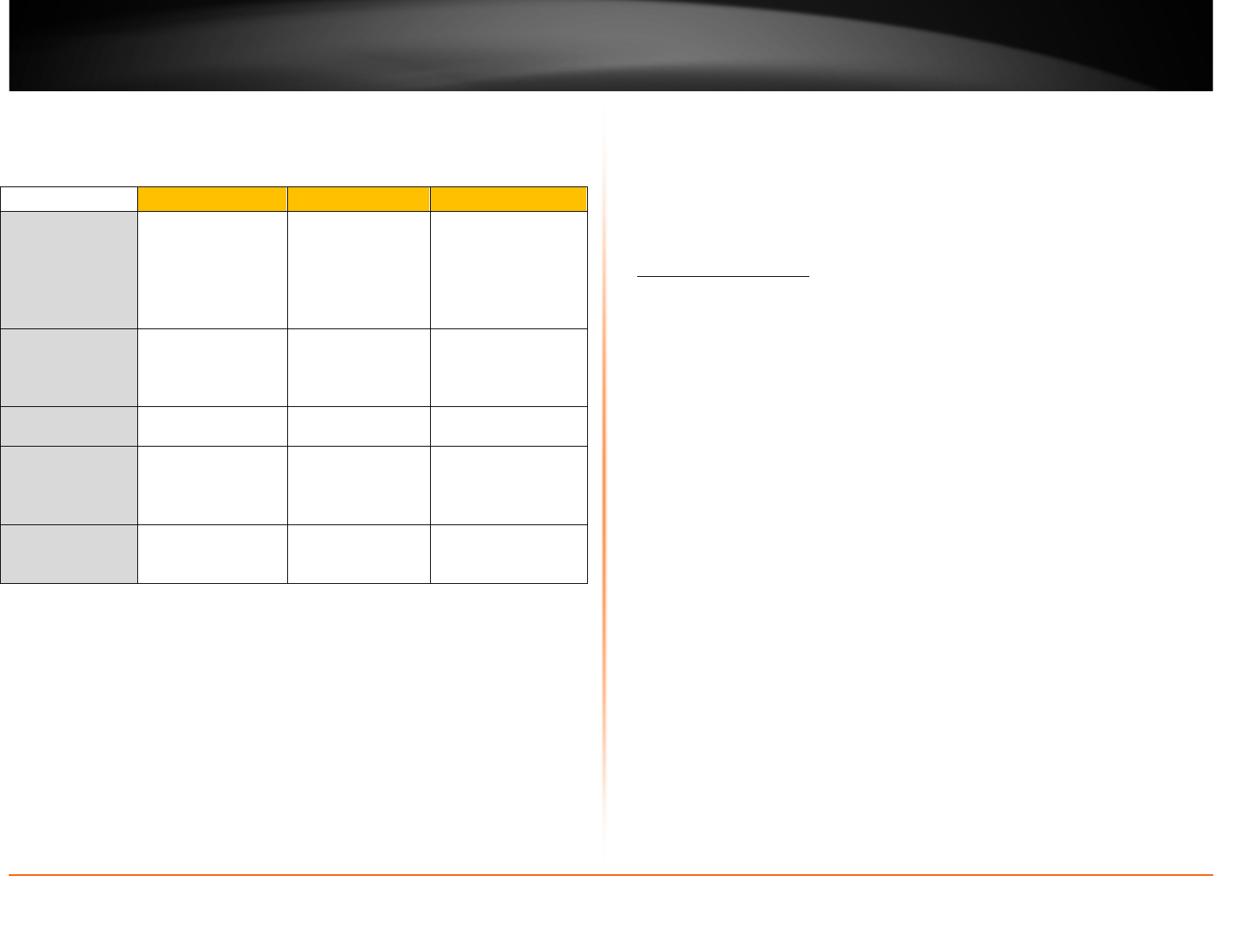
© Copyright 2013 TRENDnet. All Rights Reserved.
TRENDnet User’s Guide TEW-726EC
20
Below is brief comparison chart of the wireless security types and the recommended
configuration depending on which type you choose for your wireless network.
Security Standard
WEP
WPA
WPA2
Compatible
Wireless
Standards
IEEE 802.11a/b/g
(802.11n devices
will operate at
802.11g to connect
using this standard)
IEEE 802.11a/b/g
(802.11n devices
will operate at
802.11g to connect
using this
standard)
IEEE 802.11a/b/g/n
Highest
Performance
Under This
Setting
Up to 54Mbps
Up to 54Mbps
Up to 450Mbps*
Encryption
Strength
Low
Medium
High
Additional
Options
Open System or
Shared Key,
HEX or ASCII,
Different key sizes
TKIP or AES,
Preshared Key or
RADIUS
TKIP or AES,
Preshared Key or
RADIUS
Recommended
Configuration
Open System ASCII
13 characters
TKIP
Preshared Key
8-63 characters
AES
Preshared Key
8-63 characters
*Dependent on the maximum 802.11n data rate supported by the device (150Mbps,
300Mbps, or 450Mbps)
How to find your IP address?
Note: Please note that although the following procedures provided to follow for your
operating system on configuring your network settings can be used as general
guidelines, however, it is strongly recommended that you consult your computer or
operating system manufacturer directly for assistance on the proper procedure for
configuring network settings.
Command Prompt Method
Windows 2000/XP/Vista/7/8
1. On your keyboard, press Windows Logo+R keys simultaneously to bring up the Run
dialog box.
2. In the dialog box, type cmd to bring up the command prompt.
3. In the command prompt, type ipconfig /all to display your IP address settings.
Note: If you are experiencing difficulties, please contact your computer or operating
system manufacturer for assistance.
How to configure your network settings to obtain an IP address automatically or use
DHCP?
Note: Please note that although the following procedures provided to follow for your
operating system on configuring your network settings can be used as general
guidelines, however, it is strongly recommended that you consult your computer or
operating system manufacturer directly for assistance on the proper procedure for
configuring network settings.
Windows 8/7
a. Go into the Control Panel, click Network and Sharing Center.
b. Click Change Adapter Settings, right-click the Local Area Connection icon.
c. Then click Properties and click Internet Protocol Version 4 (TCP/IPv4).
d. Then click Obtain an IP address automatically and click OK.
Windows Vista
a. Go into the Control Panel, click Network and Internet.
b. Click Manage Network Connections, right-click the Local Area Connection
icon and click Properties.
c. Click Internet Protocol Version (TCP/IPv4) and then click Properties.

© Copyright 2013 TRENDnet. All Rights Reserved.
TRENDnet User’s Guide TEW-726EC
21
d. Then click Obtain an IP address automatically and click OK.
Windows XP/2000
a. Go into the Control Panel, double-click the Network Connections icon
b. Right-click the Local Area Connection icon and the click Properties.
c. Click Internet Protocol (TCP/IP) and click Properties.
d. Then click Obtain an IP address automatically and click OK.
MAC OS 10.4/10.5/10.6
a. From the Apple, drop-down list, select System Preferences.
b. Click the Network icon.
c. From the Location drop-down list, select Automatic.
d. Select and view your Ethernet connection.
In MAC OS 10.4, from the Show drop-down list, select Built-in
Ethernet and select the TCP/IP tab.
In MAC OS 10.5/10.6, in the left column, select Ethernet.
e. Configure TCP/IP to use DHCP.
In MAC 10.4, from the Configure IPv4, drop-down list, select Using
DHCP and click the Apply Now button.
In MAC 10.5, from the Configure drop-down list, select Using DHCP
and click the Apply button.
In MAC 10.6, from the Configure drop-down list, select Using DHCP
and click the Apply button.
f. Restart your computer.
Note: If you are experiencing difficulties, please contact your computer or operating
system manufacturer for assistance.
How to connect to a wireless network using the built-in Windows utility?
Note: Please note that although the following procedures provided to follow for your
operating system on configuring your network settings can be used as general
guidelines, however, it is strongly recommended that you consult your computer or
operating system manufacturer directly for assistance on the proper procedure for
connecting to a wireless network using the built-in utility.
Windows 8/7
1. Open Connect to a Network by clicking the network icon ( or ) in the notification
area.
2. In the list of available wireless networks, click the wireless network you would like to
connect to, then click Connect.
4. You may be prompted to enter a security key in order to connect to the network.
5. Enter in the security key corresponding to the wireless network, and click OK.
Windows Vista
1. Open Connect to a Network by clicking the Start Button. and then click Connect
To.
2. In the Show list, click Wireless.
3. In the list of available wireless networks, click the wireless network you would like to
connect to, then click Connect.
4. You may be prompted to enter a security key in order to connect to the network.
5. Enter in the security key corresponding to the wireless network, and click OK.
Windows XP
1. Right-click the network icon in the notification area, then click View Available
Wireless Networks.
2. In Connect to a Network, under Available Networks, click the wireless network you
would like to connect to.
3. You may be prompted to enter a security key in order to connect to the network.
4. Enter in the security key corresponding to the wireless network, and click Connect.
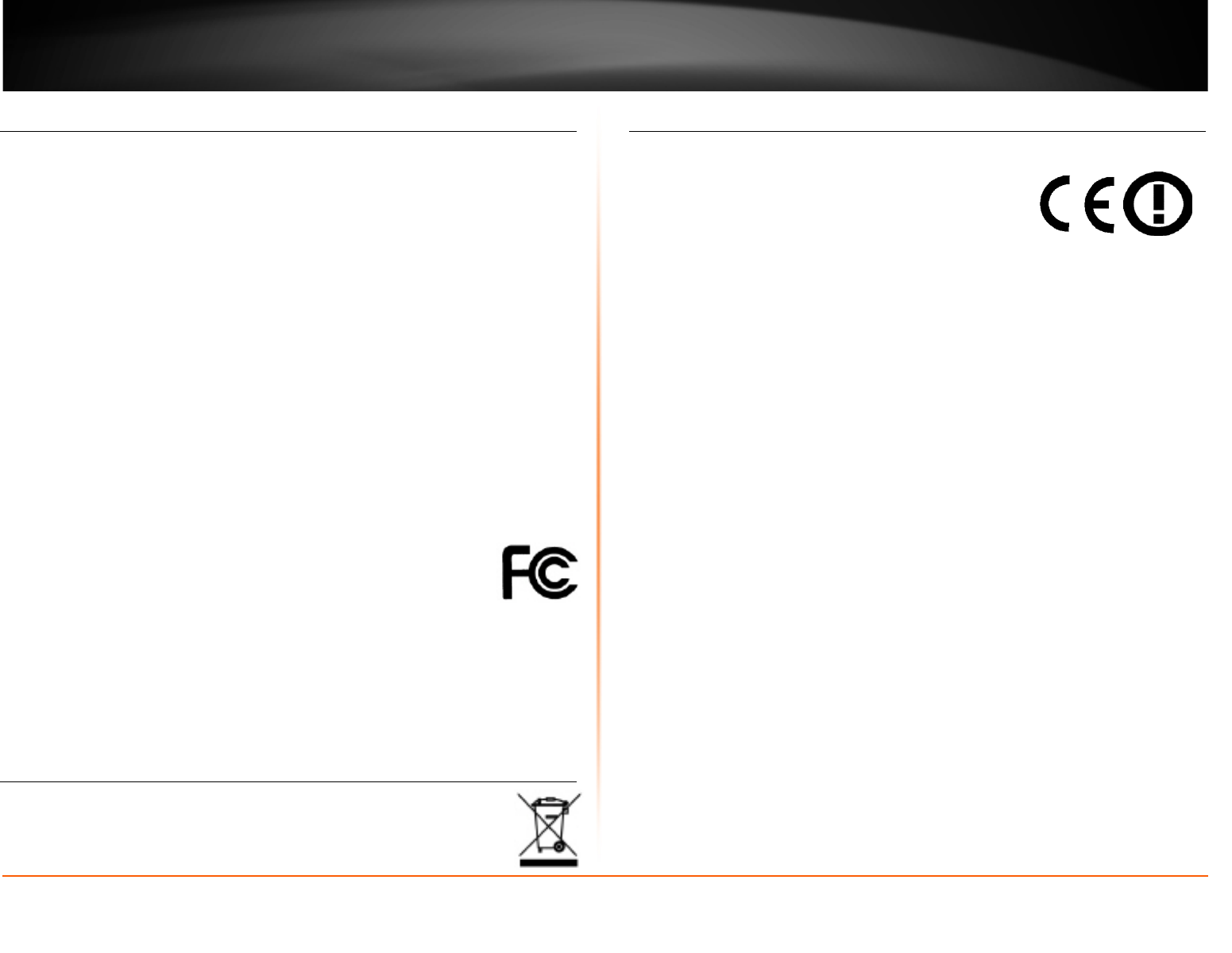
© Copyright 2013 TRENDnet. All Rights Reserved.
TRENDnet User’s Guide TEW-726EC
22
Federal Communication Commission Interference Statement
This equipment has been tested and found to comply with the limits for a Class B digital
device, pursuant to Part 15 of the FCC Rules. These limits are designed to provide
reasonable protection against harmful interference in a residential installation. This
equipment generates, uses and can radiate radio frequency energy and, if not installed
and used in accordance with the instructions, may cause harmful interference to radio
communications. However, there is no guarantee that interference will not occur in a
particular installation. If this equipment does cause harmful interference to radio or
television reception, which can be determined by turning the equipment off and on, the
user is encouraged to try to correct the interference by one of the following measures:
• Reorient or relocate the receiving antenna.
• Increase the separation between the equipment and receiver.
• Connect the equipment into an outlet on a circuit different from that to which
the receiver is connected.
• Consult the dealer or an experienced radio/TV technician for help.
FCC Caution: Any changes or modifications not expressly approved by the party
responsible for compliance could void the user's authority to operate this equipment.
This device complies with Part 15 of the FCC Rules. Operation is subject to the following
two conditions: (1) This device may not cause harmful interference, and (2) this device
must accept any interference received, including interference that may cause undesired
operation.
IMPORTANT NOTE:
FCC Radiation Exposure Statement:
This equipment complies with FCC radiation exposure limits set forth for an
uncontrolled environment. This equipment should be installed and operated with
minimum distance 20cm between the radiator & your body. This transmitter must not
be co-located or operating in conjunction with any other antenna or transmitter. This
product will be used for indoor operations.
RoHS
This product is RoHS compliant.
Europe – EU Declaration of Conformity
This product is herewith confirmed to comply with the Directive of 1999/5/EC and
2006/95/EC.
EN60950-1: 2006 + A11 : 2009 + A1 : 2010 + A12 : 2011
Safety of Information Technology Equipment
EN 300 328 V1.7.1 (2006-10) Class B
Electromagnetic compatibility and Radio spectrum Matters (ERM); Wideband
transmission systems; Data transmission equipment operating in the 2,4 GHz ISM band
and using wide band modulation techniques; Harmonized EN covering essential
requirements under article 3.2 of the R&TTE Directive
EN 301 489-1 V1.9.2 (2011-09)
Electromagnetic compatibility and Radio Spectrum Matters (ERM); ElectroMagnetic
Compatibility (EMC) standard for radio equipment and services; Part 1: Common
technical requirements
EN 301 489-17 V2.2.1 (2012-09)
Electromagnetic compatibility and Radio spectrum Matters (ERM); ElectroMagnetic
Compatibility (EMC) standard for radio equipment and services; Part 17: Specific
conditions for 2,4 GHz wideband transmission systems and 5 GHz high performance
RLAN equipment
EN 301 893 : V1.6.1
EN 62311 : 2008
This device is a 2.4 GHz wideband transmission system (transceiver), intended for use in
all EU member states and EFTA countries, except in France and Italy where restrictive
use applies. In Italy the end-user should apply for a license at the national spectrum
authorities in order to obtain authorization to use the device for setting up outdoor
radio links and/or for supplying public access to telecommunications and/or network
services. This device may not be used for setting up outdoor radio links in France and in
some areas the RF output power may be limited to 10 mW EIRP in the frequency range
of 2454 – 2483.5 MHz. For detailed information the end-user should contact the
national spectrum authority in France.
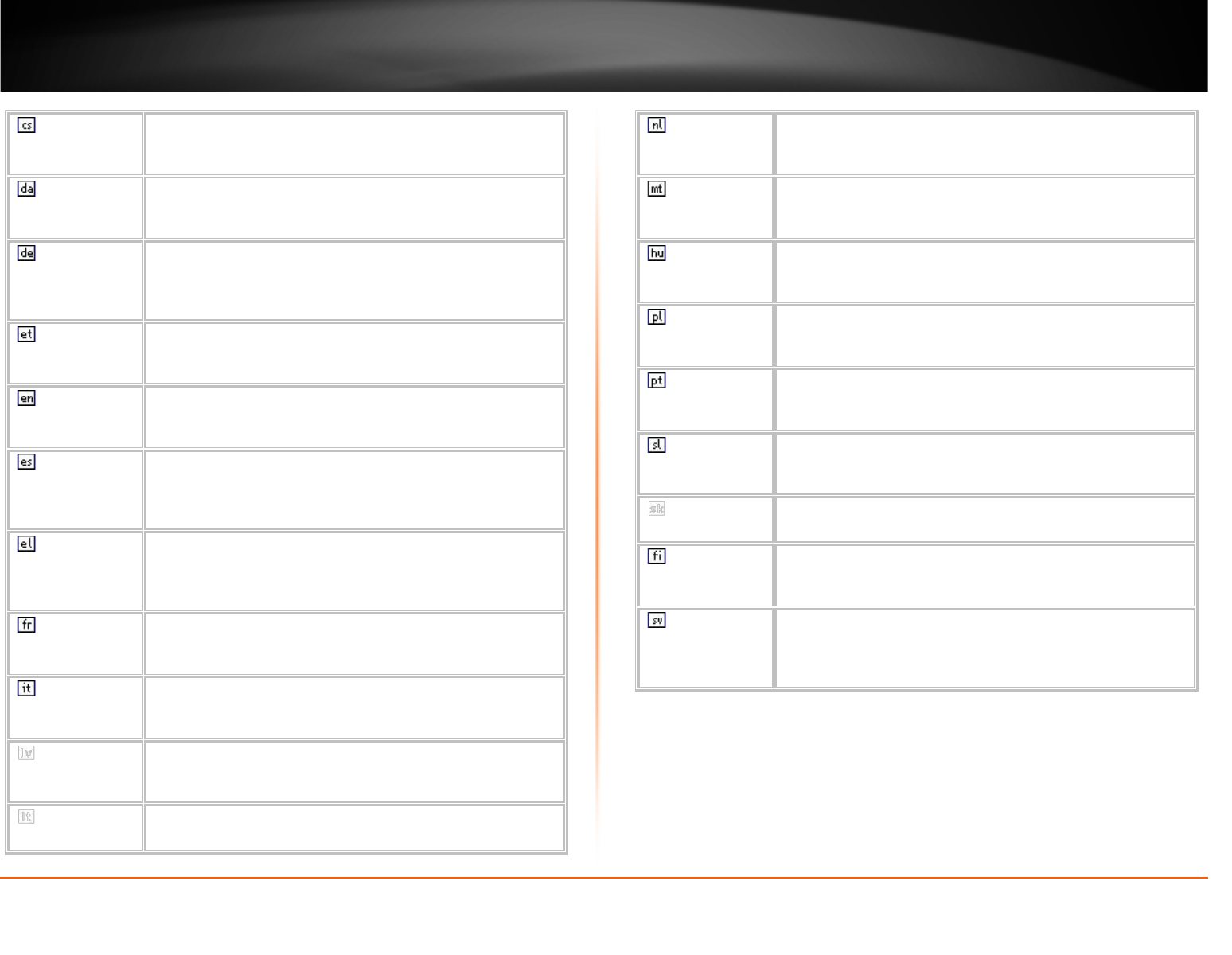
© Copyright 2013 TRENDnet. All Rights Reserved.
TRENDnet User’s Guide Limited Warranty
23
Česky [Czech] TRENDnet tímto prohlašuje, že tento TEW-726EC je ve shodě se
základními požadavky a dalšími příslušnými ustanoveními směrnice
1999/5/ES a 2006/95/ES.
Dansk [Danish] Undertegnede TRENDnet erklærer herved, at følgende udstyr TEW-
726EC overholder de væsentlige krav og øvrige relevante krav i
direktiv 1999/5/EF og 2006/95/EF.
Deutsch
[German]
Hiermit erklärt TRENDnet, dass sich das Gerät TEW-726EC in
Übereinstimmung mit den grundlegenden Anforderungen und den
übrigen einschlägigen Bestimmungen der Richtlinie 1999/5/EG und
2006/95/EG befindet.
Eesti [Estonian] Käesolevaga kinnitab TRENDnet seadme TEW-726EC vastavust
direktiivi 1999/5/EÜ ja 2006/95/EÜ põhinõuetele ja nimetatud
direktiivist tulenevatele teistele asjakohastele sätetele.
English Hereby, TRENDnet, declares that this TEW-726EC is in compliance
with the essential requirements and other relevant provisions of
Directive 1999/5/EC and 2006/95/EC.
Español
[Spanish]
Por medio de la presente TRENDnet declara que el TEW-726EC
cumple con los requisitos esenciales y cualesquiera otras
disposiciones aplicables o exigibles de la Directiva 1999/5/CE, y
2006/95/CE.
Ελληνική
[Greek]
ΜΕ ΤΗΝ ΠΑΡΟΥΣΑTRENDnet ΔΗΛΩΝΕΙ ΟΤΙTEW-
726ECΣΥΜΜΟΡΦΩΝΕΤΑΙ ΠΡΟΣ ΤΙΣ ΟΥΣΙΩΔΕΙΣ ΑΠΑΙΤΗΣΕΙΣ ΚΑΙ ΤΙΣ
ΛΟΙΠΕΣ ΣΧΕΤΙΚΕΣ ΔΙΑΤΑΞΕΙΣ ΤΗΣ ΟΔΗΓΙΑΣ 1999/5/ΕΚ, 2006/95/ΕΚ
και.
Français
[French]
Par la présente TRENDnet déclare que l'appareil TEW-726EC est
conforme aux exigences essentielles et aux autres dispositions
pertinentes de la directive 1999/5/CE, 2006/95/CE et.
Italiano[Italian] Con la presente TRENDnet dichiara che questo TEW-726EC è
conforme ai requisiti essenziali ed alle altre disposizioni pertinenti
stabilite dalla direttiva 1999/5/CE e 2006/95/CE.
Latviski [Latvian] AršoTRENDnetdeklarē, ka TEW-726EC atbilstDirektīvas 1999/5/EK, un
2006/95/EK būtiskajāmprasībām un citiemar to
saistītajiemnoteikumiem.
Lietuvių
[Lithuanian]
Šiuo TRENDnet deklaruoja, kad šis TEW-726EC atitinka esminius
reikalavimus ir kitas 1999/5/EB ir 2006/95/EB Direktyvos nuostatas.
Nederlands
[Dutch]
Hierbij verklaart TRENDnet dat het toestel TEW-726EC in
overeenstemming is met de essentiële eisen en de andere relevante
bepalingen van richtlijn 1999/5/EG, en 2006/95/EG.
Malti [Maltese] Hawnhekk, TRENDnet, jiddikjara li dan TEW-726EC jikkonforma mal-
ħtiġijiet essenzjali u ma provvedimenti oħrajn relevanti li hemm fid-
Dirrettiva 1999/5/KE u 2006/95/KE.
Magyar
[Hungarian]
Alulírott, TRENDnet nyilatkozom, hogy a TEW-726ECmegfelel a
vonatkozó alapvetõ követelményeknek és az 1999/5/EK irányelv, a
2006/95/EK irányelv egyéb elõírásainak.
Polski [Polish] Niniejszym TRENDnet oświadcza, że TEW-726EC jest zgodny z
zasadniczymi wymogami oraz pozostałymi stosownymi
postanowieniami Dyrektywy 1999/5/WE i 2006/95/WE.
Português
[Portuguese]
TRENDnet declara que este TEW-726EC está conforme com os
requisitos essenciais e outras disposições da Directiva 1999/5/CE e
2006/95/CE.
Slovensko
[Slovenian]
TRENDnet izjavlja, da je ta TEW-726EC v skladu z bistvenimi
zahtevami in ostalimi relevantnimi določili direktive 1999/5/ES in
2006/95/ES.
Slovensky
[Slovak]
TRENDnettýmtovyhlasuje, že TEW-726ECspĺňazákladnépožiadavky a
všetkypríslušnéustanoveniaSmernice 1999/5/ES a 2006/95/ES.
Suomi [Finnish] TRENDnet vakuuttaa täten että TEW-726EC tyyppinen laite on
direktiivin 1999/5/EY ja 2006/95/EY oleellisten vaatimusten ja sitä
koskevien direktiivin muiden ehtojen mukainen.
Svenska
[Swedish]
Härmed intygar TRENDnet att denna TEW-726EC står I
överensstämmelse med de väsentliga egenskapskrav och övriga
relevanta bestämmelser som framgår av direktiv 1999/5/EG och
2006/95/EG.
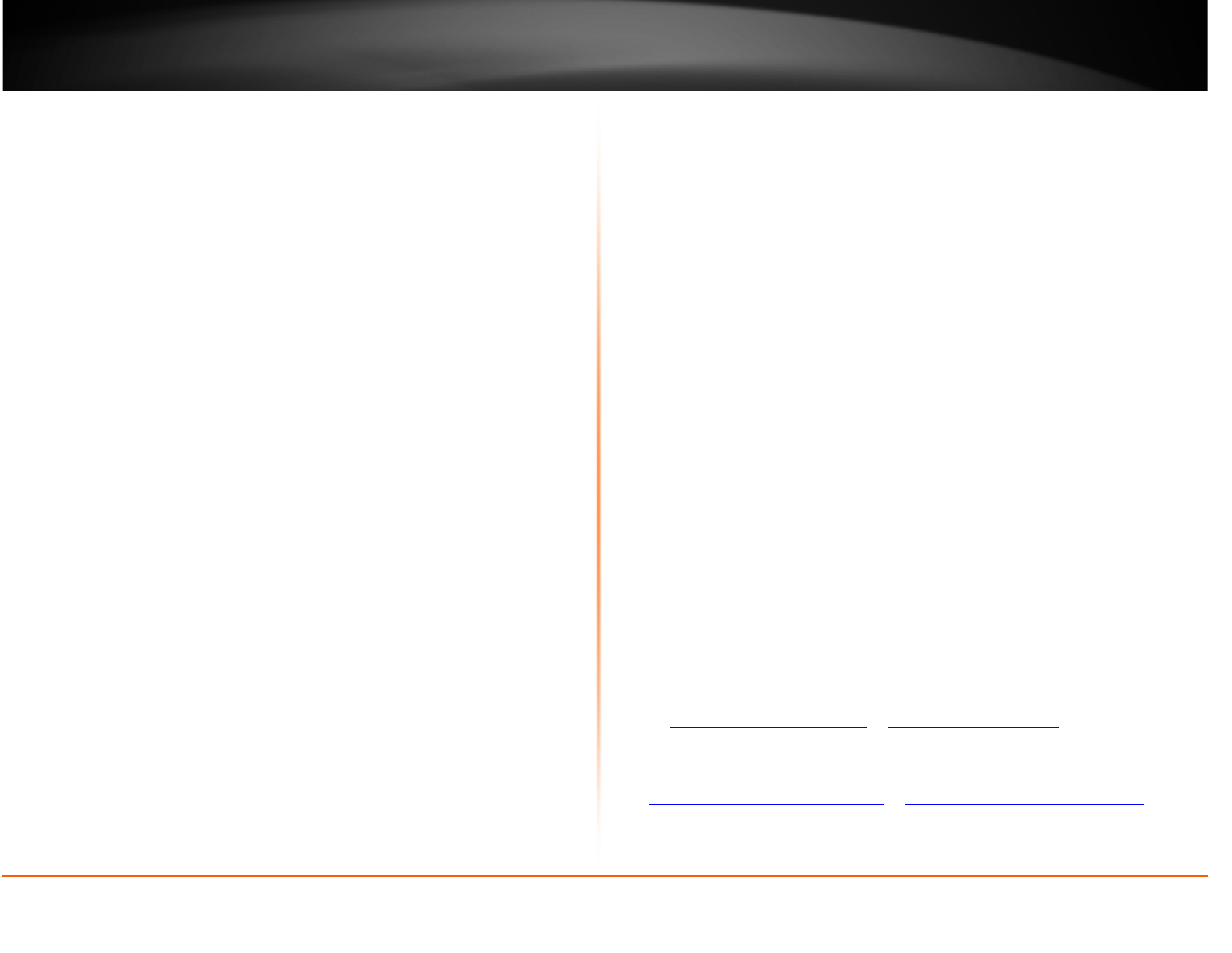
© Copyright 2013 TRENDnet. All Rights Reserved.
TRENDnet User’s Guide Limited Warranty
24
Limited Warranty
TRENDnet warrants its products against defects in material and workmanship, under
normal use and service, for the following lengths of time from the date of purchase.
TEW-726EC – 3 Years Warranty
AC/DC Power Adapter, Cooling Fan, and Power Supply carry 1 year warranty.
If a product does not operate as warranted during the applicable warranty period,
TRENDnet shall reserve the right, at its expense, to repair or replace the defective
product or part and deliver an equivalent product or part to the customer. The
repair/replacement unit’s warranty continues from the original date of purchase. All
products that are replaced become the property of TRENDnet. Replacement products
may be new or reconditioned. TRENDnet does not issue refunds or credit. Please
contact the point-of-purchase for their return policies.
TRENDnet shall not be responsible for any software, firmware, information, or memory
data of customer contained in, stored on, or integrated with any products returned to
TRENDnet pursuant to any warranty.
There are no user serviceable parts inside the product. Do not remove or attempt to
service the product by any unauthorized service center. This warranty is voided if (i) the
product has been modified or repaired by any unauthorized service center, (ii) the
product was subject to accident, abuse, or improper use (iii) the product was subject to
conditions more severe than those specified in the manual.
Warranty service may be obtained by contacting TRENDnet within the applicable
warranty period and providing a copy of the dated proof of the purchase. Upon proper
submission of required documentation a Return Material Authorization (RMA) number
will be issued. An RMA number is required in order to initiate warranty service support
for all TRENDnet products. Products that are sent to TRENDnet for RMA service must
have the RMA number marked on the outside of return packages and sent to TRENDnet
prepaid, insured and packaged appropriately for safe shipment. Customers shipping
from outside of the USA and Canada are responsible for return shipping fees. Customers
shipping from outside of the USA are responsible for custom charges, including but not
limited to, duty, tax, and other fees.
WARRANTIES EXCLUSIVE: IF THE TRENDNET PRODUCT DOES NOT OPERATE AS
WARRANTED ABOVE, THE CUSTOMER’S SOLE REMEDY SHALL BE, AT TRENDNET’S
OPTION, REPAIR OR REPLACE. THE FOREGOING WARRANTIES AND REMEDIES ARE
EXCLUSIVE AND ARE IN LIEU OF ALL OTHER WARRANTIES, EXPRESSED OR IMPLIED,
EITHER IN FACT OR BY OPERATION OF LAW, STATUTORY OR OTHERWISE, INCLUDING
WARRANTIES OF MERCHANTABILITY AND FITNESS FOR A PARTICULAR PURPOSE.
TRENDNET NEITHER ASSUMES NOR AUTHORIZES ANY OTHER PERSON TO ASSUME FOR
IT ANY OTHER LIABILITY IN CONNECTION WITH THE SALE, INSTALLATION MAINTENANCE
OR USE OF TRENDNET’S PRODUCTS.
TRENDNET SHALL NOT BE LIABLE UNDER THIS WARRANTY IF ITS TESTING AND
EXAMINATION DISCLOSE THAT THE ALLEGED DEFECT IN THE PRODUCT DOES NOT EXIST
OR WAS CAUSED BY CUSTOMER’S OR ANY THIRD PERSON’S MISUSE, NEGLECT,
IMPROPER INSTALLATION OR TESTING, UNAUTHORIZED ATTEMPTS TO REPAIR OR
MODIFY, OR ANY OTHER CAUSE BEYOND THE RANGE OF THE INTENDED USE, OR BY
ACCIDENT, FIRE, LIGHTNING, OR OTHER HAZARD.
LIMITATION OF LIABILITY: TO THE FULL EXTENT ALLOWED BY LAW TRENDNET ALSO
EXCLUDES FOR ITSELF AND ITS SUPPLIERS ANY LIABILITY, WHETHER BASED IN
CONTRACT OR TORT (INCLUDING NEGLIGENCE), FOR INCIDENTAL, CONSEQUENTIAL,
INDIRECT, SPECIAL, OR PUNITIVE DAMAGES OF ANY KIND, OR FOR LOSS OF REVENUE OR
PROFITS, LOSS OF BUSINESS, LOSS OF INFORMATION OR DATE, OR OTHER FINANCIAL
LOSS ARISING OUT OF OR IN CONNECTION WITH THE SALE, INSTALLATION,
MAINTENANCE, USE, PERFORMANCE, FAILURE, OR INTERRUPTION OF THE POSSIBILITY
OF SUCH DAMAGES, AND LIMITS ITS LIABILITY TO REPAIR, REPLACEMENT, OR REFUND
OF THE PURCHASE PRICE PAID, AT TRENDNET’S OPTION. THIS DISCLAIMER OF LIABILITY
FOR DAMAGES WILL NOT BE AFFECTED IF ANY REMEDY PROVIDED HEREIN SHALL FAIL
OF ITS ESSENTIAL PURPOSE.
Governing Law: This Limited Warranty shall be governed by the laws of the state of
California.
Some TRENDnet products include software code written by third party developers.
These codes are subject to the GNU General Public License ("GPL") or GNU Lesser
General Public License ("LGPL").
Go to http://www.trendnet.com/gpl or http://www.trendnet.com Download section
and look for the desired TRENDnet product to access to the GPL Code or LGPL Code.
These codes are distributed WITHOUT WARRANTY and are subject to the copyrights of
the developers. TRENDnet does not provide technical support for these codes. Please go
to http://www.gnu.org/licenses/gpl.txt or http://www.gnu.org/licenses/lgpl.txt for
specific terms of each license.
PWP05202009v2 2013/02/28
